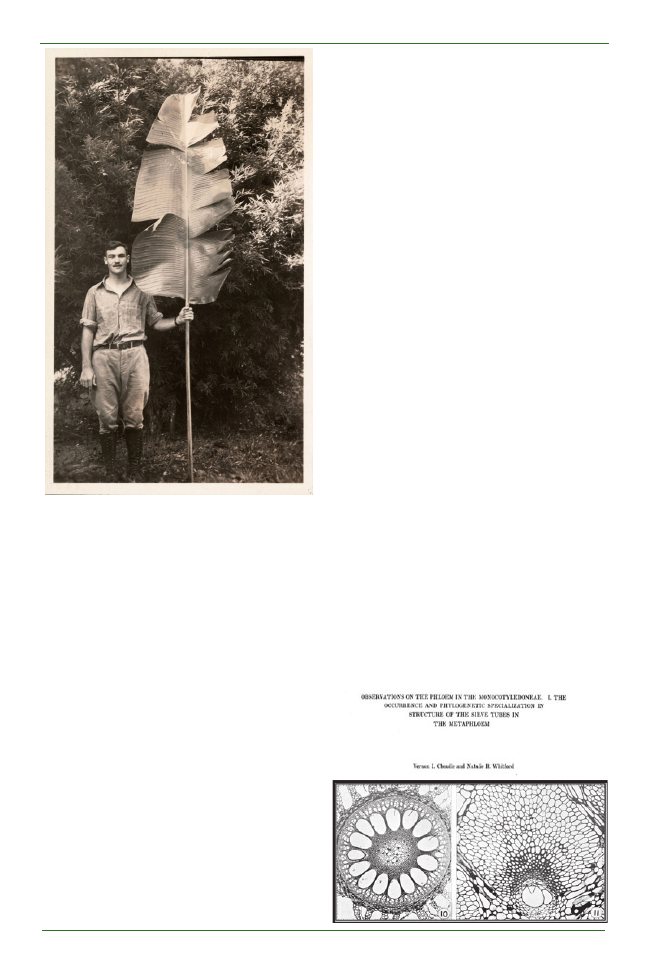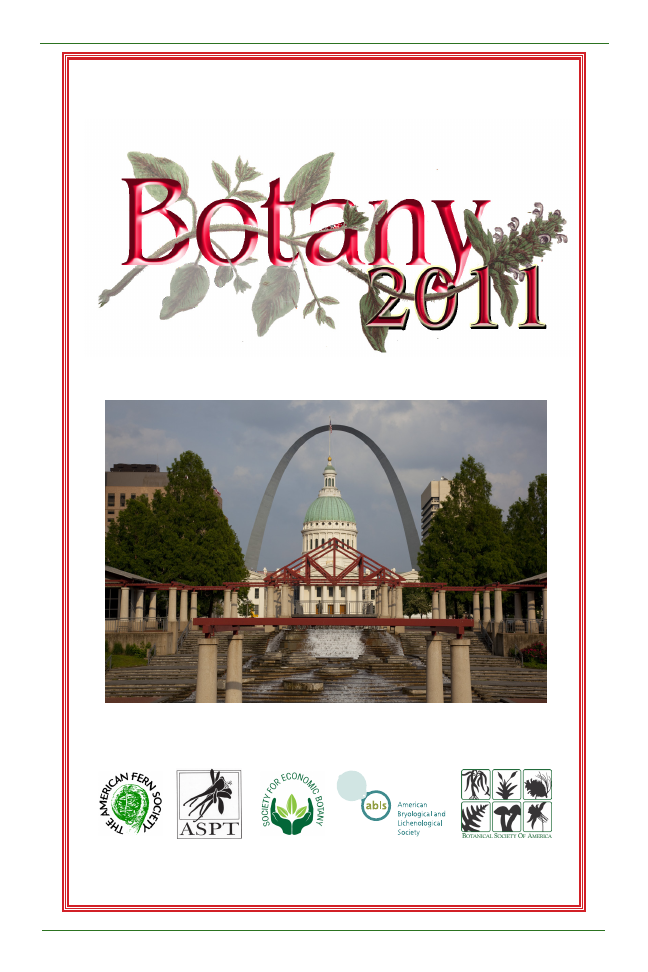
149
Plant Science Bulletin 56(4) 2010
WINTER 2010
VOLUME 56 NUMBER 4
PLANT SCIENCE
ISSN 0032-0919
The Botanical Society of America: The Society for ALL Plant Biologists
THE BOTANICAL SOCIETY OF AMERICA
Leading Scientists
and
Educators
since 1893
BULLETIN
News from the Society
BSA Awards........................................................................................150
Good Green Teaching Colleagues.........................................................151
BSA Education News and Notes.........................................................154
In Memoriam
Lawrence Joseph Crockett (1926-2010)..............................................157
Personalia
Dr. Peter Raven receives the William L. Brown Award for Excellence in
Genetic Resource Conservation............................................160
Friedman named Director of Arnold Arboretum....................................160
Special Opportunities
New Non-Profit Directly Links Donors to Researchers......................162
Harvard University Bullard Fellowships in Forest Research...............163
MicroMorph........................................................................................163
Courses/Workshops
Experience in Tropical Botany.............................................................165
Reports and Reviews
Armen Takhtajan – In Appreciation of His Life. Raven, Peter H.and
Tatyana Shulkina..................................................................166
Thoughts on Vernon I. Cheadle. Evert, Ray F. and Natalie W. Uhl.....171
Books Reviewed in this Issue
............................................................................176
Books Received
....................................................................................................183
Botany 2011
.........................................................................................................184

150
Plant Science Bulletin 56(4) 2010
P
LANT
S
CIENCE
B
ULLETIN
POSTMASTER: Send address changes to:
Botanical Society of America
Business Office
P.O. Box 299
St. Louis, MO 63166-0299
E-mail: bsa-manager@botany.org
Address Editorial Matters (only) to:
Marshall D. Sundberg, Editor
Dept. Biol. Sci., Emporia State Univ.
1200 Commercial St.
Emporia, KS 66801-5057
Phone 620-341-5605
E-mail: psb@botany.org
ISSN 0032-0919
Published quarterly by Botanical Society of America, Inc., 4475 Castleman Avenue, St. Louis,
MO 63166-0299. The yearly subscription rate of $15 is included in the membership dues of
the Botanical Society of America, Inc. Periodical postage paid at St. Louis, MO and additional
mailing office.
News from the Society
BSA Awards
One of the most important aspects of BSA
membership is having the opportunity to award
peers and/or student members for outstanding
efforts in support of our mission via the Society
awards program. To access the award
information, please go to
www.botany.org/
awards/
.
Please take the time to use this valuable benefit
over the next few months as we ask for
nominations for the 2011 awards. Promoting
botany and botanists is your privilege and
responsibility.
Awards Open through March 15, 2011
-Merit Award
-Charles E. Bessey Teaching Award
-Grady L. Webster Structural Botany
Publication Award
-John S. Karling and the BSA Graduate Student
Research Awards
-Undergraduate Student Research Awards
-Genetics Section Graduate Student
Research Awards
-Young Botanist Awards
Awards Open through April 1, 2011
-Jeanette Siron Pelton Award in Experimental
Plant Morphology
Editorial Manager for Plant Science Bulletin is
now live. To submit manuscripts for
consideration please go to:
http://
www.editorialmanager.com/psb/.
We
encourage all of the membership to register
as potential manuscript reviewers by visiting
that site and clicking on “Update My
Information.” This is especially important for
members of the Teaching, Historical, and
Economic Botany sections who are under-
represented in the current AJB reviewer data
base.
We also encourage all members of the society
to consider nominating individuals for the
various society and sectional awards listed on
the facing page. It is important to recognize
botanical colleagues for the fine work they do
and especially to support younger botanists in
the early stages of their careers. If you search
previous issues of PSB (it is searchable on the
BSA web site) for previous award winners, you
will notice that certain schools and certain
nominators are consistently recognized. It
may be that we have only a few star programs,
but it is more likely that this pattern results from
a relatively few individuals committed to
promoting botany at their institutions. Become
one of the few! Botany needs you!
In this issue we recognize two eminent
botanists who were leaders in the field, the
systematist Armen Takhtajan and the
anatomist Vernon Cheadle. In both cases the
authors go beyond the botany to provide
interesting perspectives of the life situation
and personal character of these inspiring
botanists. Read and enjoy.
-the Editor

151
Plant Science Bulletin 56(4) 2010
Editorial Committee for Volume 56
Nina L. Baghai-Riding (2010)
Division of Biological and
Physical Sciences
Delta State University
Cleveland, MS 38733
nbaghai@deltastate.edu
P
LANT
S
CIENCE
B
ULLETIN
Jenny Archibald (2011)
Department of Ecology
and Evolutionary Biology
The University of Kansas
Lawrence, Kansas 66045
jkarch@ku.edu
Root Gorelick (2012)
Department of Biology
Carleton University
Ottawa, Ontario
Canada, K1H 5N1
Root_Gorelick@carleton.ca
Elizabeth Schussler (2013)
Department of Ecology and
Evolutionary Biology
University of Tennessee
Knoxville, TN 37996-1610
eschussl@utk.edu
Christopher Martine
Department of Biology
State University of New York
at Plattsburgh
Plattsburgh, NY 12901-2681
martinct@plattsburgh.edu
-Darbaker Prize in Phycology
Student Travel Awards for Botany &
Economic Botany 2011, Open through April
10, 2011
-Vernon I. Cheadle STA
-Triarch “Botanical Images” STA
Section Student Travel Awards
-Pteridological Section & American
Fern Society
-Developmental & Structural Section
-Ecological Section
-Genetics Section
-Mycological Section
-Phycological Section
-Phytochemical Section
BSA Corresponding Members Outside of the
award program, the Botanical Society is active
in honoring Botanists where ever possible.
The most prestigious form this takes is when
a member like you nominates an overseas
colleague as a BSA Corresponding Member.
For many years this honor was limited to 50
people but in 2006, the Society removed this
limit to make it more available to deserving
international botanists. Corresponding
membership in the BSA is an internationally
recognized honor, and is particularly important
today with the ease in building relationships
in a virtual world. Please take the time to
consider nominating your international
colleagues for the important distinction of being
a BSA Corresponding Member. For details
s e e :
w w w . b o t a n y . o r g / a b o u t _ b s a /
corresponding_members.php
Good Green Teaching
Colleagues
The 2009 BSA Education Summit report,
available at:
http://www.botany.org/bsa/membership/
council2010/DAL-Education.pdf
The Education Summit was conceived as a
way to gain better perspectives on the various
education activities in the BSA and to parse the
BSA education objectives into the best hands
to ensure that progress is made. Based on the
Strategic Plan that is guiding the future of the
BSA, we focused on what we can and should
do to meet the goals that have been established.
We also discussed the roles of the different
education-oriented entities in the BSA and
developed action plans to achieve the goals
that we established. Below, these action plans
are developed as recommendations.
The strategic plan emphasizes that the BSA
should seek to provide botany resources for
teachers. We concurred and discussed the
best ways to meet this plant information
expectation. To meet the goal of locating and
engaging BSA experts who can contribute facts
and information about plants, we noted that the
plans for the new Membership Directory will
include opportunities to collect and display
such information about members. The
Directory will be searchable for membership
expertise.
To gather information about experts who will
identify gaps in existing instructional materials,
we recommend developing a new box on the

152
Plant Science Bulletin 56(4) 2010
abstract submission form for the annual
meeting. This box would solicit information
from “experts” on the nature and progress on
the “broader impacts” component of funded
research projects. We reasoned that BSA
members with active, well supported research
programs would be the ones with the “broader
impacts” statements and plans. With
information about ongoing activities, we should
be able to discover what ongoing education
projects might be made more public and could
provide topics for education symposia and
workshops at the annual meeting. This will
also meet the goal of fostering collaboration
among BSA members to share information
and ideas about education initiatives.
Claire Hemmingway guided a discussion of
PlantingScience progress and new objectives.
She noted that summer institutes, held at Texas
A&M University, provided opportunities for
exploring active learning activities and
conducting focus groups with teachers to help
them implement these active learning
possibilities. She also discussed expanding
the roles of mentors in helping to initiate and
conduct experiments with teachers and
students, and she introduced how video clips

153
Plant Science Bulletin 56(4) 2010
were helping teachers gain a better
understanding of some concepts and
methods. Claire provided information about a
goal of the PlantingScience program to help
teachers learn how to cover the field of biology
using plants (“Planting across the
curriculum.”). Assessment of the program is
essential, but has been challenging and is still
an elusive ultimate goal. She noted that
questionnaires provided to participants as well
as Pre-and Post testing of students was
involved as was tracking teachers and their
successes with the program in their classes.
Carol Stuessey has been the point person in
developing a plan to develop meaningful and
effective assessment of the program so that its
contributions can be fully demonstrated. We
strongly encouraged progress on this
important component of PlantingScience so
that the program could have more promise of
integration with state standards and testing.
We also noted that continued and expanded
funding for PlantingScience was likely to
depend on well-documented and analyzed
evidence of its effectiveness.
Bill Dahl reported on recent discussions in
Washington, DC involving the Obama
administration’s response to the current
nationwide scientific literacy crisis. Politicians
are seeking ways to generate more science
teachers who will incorporate more inquiry
methods in student learning. Interdisciplinary
society participation has been sought through
the coordination of fields and programs
represented by members of the Council of
Scientific Society Presidents. This group is
pushing plans for a “Science Week” program
to highlight progress and goals for future
science education.
We discussed options for developing outreach
by BSA professionals to students in their local
city and regional neighborhoods, and that this
has been supported in some instances by
NSF funding. We noted that such outreach
might be best targeted at making connections
between 4-year colleges and the Community
Colleges where an offer of expertise is likely to
be well received. We recommended
establishing information on the membership
form to ask whether individuals would be open
to inquiries from their community to answer
science questions and serve in an “Ask a
Botanist” capacity. The BSA could function as
a clearinghouse and communication hub for
making such connections. These connections
might also lead to more community college
professionals seeking membership in the
BSA. We also noted that the BSA may be able
to serve as a place for certifying the quality of on-
line courses, helping students know which
courses will provide the education outcomes
that they seek.
Chris Martine discussed his success in
establishing a student chapter of the BSA,
getting students involved with neighborhood
activities and involving them in service to the
community. We recommend having a
workshop on student chapters at the annual
meeting.
We considered it to be a valuable BSA
contribution for us to develop assessments of
teaching modules, but we wondered how to
generate funding for such assessments. We
already have some PlantingScience modules
and curricula that meet some state standards
and the goals of assessment tests of students.
But we need more of them for teachers to use
as well as for the education of new teachers
(pre-service training).
We recommended building on the fine work of
Chris Martine, who has developed videos to
inform children about aspects of science in
general and botany in particular. To develop
this agenda, we recommend providing
opportunities at our annual meeting to conduct
video interviews with experts attending the
meeting. Not only would this help to explore
topics that might be expanded into new video
segments, but it would also discover which
BSA colleagues are ideally suited for this video
medium, and whose research might be used
to illustrate science principles and practices.
We might also be able to develop “How To”
videos of various techniques and procedures.
We devoted some discussion to the opportunity
for certification of individuals as “Botanists.”
We concluded that we need to review the
competencies necessary to be certified.
Robynn Shannon commented that the
Ecological Society of America has developed a
certification program and we might be able to
learn from their efforts and adopt some of their

154
Plant Science Bulletin 56(4) 2010
BSA Science Education
News and Notes
methods. We recommended forming a
committee to explore these options and
develop recommendations that would be
reviewed by the Education Committee and
ultimately forwarded to the Board of Directors
for discussion and implementation. Members
of that exploration committee could include
Marsh Sundberg (who has been working with
the National Forest Service to develop a
certification option), Robynn Shannon, Krissa
Skogen, and Bill Dahl.
Through the meeting, we devoted time and
thought to exploring and defining the roles of
the Education Committee and the Teaching
Section of the BSA. After considerable
discussion, we concluded that the Education
Committee meets the governance function in
education for the BSA, i.e., implementing the
educational mission of the BSA and
recommending policies that will help the BSA
achieve its education mission. Thus, the
Education Committee would be charged with
organizing society-wide education initiatives
at annual meetings (such as opportunities for
workshops and forums on education). The
Teaching Section would function to serve the
members of that section, by organizing
contributed papers sessions and symposia of
interest to those members. Thus, both the
Education Committee and the Teaching
Section provide vital and complementary
contributions to the BSA and its members. We
recommend that special attention be paid to
appointing Education Committee members
so that those interested in meeting BSA
education goals will be involved and we
recommend appointing a member of the
Teaching Section as an ex officio member of
the Education Committee. Normally, this
would be the Chair of the Teaching Section, but
another individual may be appointed as
appropriate.
We note that the we are working toward
achieving the strategic goals established by
the BSA strategic planning committee and we
are now poised to have a better sense of how
to coordinate and develop cooperation among
the various components of the BSA that
address education aspects of the Society.
I personally thank the members who took time
out of their obviously busy schedules to attend
this Summit and contribute their expertise and
perspectives on education and the BSA. We
certainly had a productive and valuable meeting
that should translate in an improved and
invigorated education mission of the BSA.
Respectfully submitted,
Chris Haufler, Board of Directors Member
associated with BSA education
BSA Science Education News and Notes is a
quarterly update about the BSA’s education
efforts and the broader education scene. We
invite you to submit news items or ideas for
future features. Contact: Claire Hemingway,
BSA Education Director, at
chemingway@botany.org
or Marshall
Sundberg, PSB Editor, at
psb@botany.org
.
PlantingScience — BSA-led student research
and science mentoring program
PlantingScience Online Mentored Inquiry
Session.
“We posted our research question on our wall
and we are ready to get to work.”
“Hello!! I can’t wait to meet the mentors and start
this project. I’m not very good with science so
hopefully I will learn a few new things!!”
“… Plants are so interesting at first i didnt think
i would like this class but the more i got into it the
more i liked it! … We posted our ideas for our
experiment. Let us know what you think!”
“We have everything in order for our experiment.
I’m getting excited I can’t wait to find out how it
turns out. Maybe then I can get the answer I’m
searching for. Does moisture in the soil affect
plant life? Well the research will tell all soon
enough”
Students share their excitement with scientist
mentors as the fall 2010 session kicks off. By
the time the online session ends in November
we expect 25 schools from 14 states across the

155
Plant Science Bulletin 56(4) 2010
nation to take part, including 4 middle schools,
20 high school classes, and one university.
This session marks the largest array of inquiry
modules available (the Wonder of Seeds—
seed germination and seedling growth; Power
of Sunlight—photosynthesis and respiration;
Foundations of Genetics—traits, variation, and
environment in Rapid Cycling Brassica) and in
field testing (Where does pollen come from?—
pollen and pollination; Celery Challenge—
osmosis, diffusion, and transpiration; C-Fern®
in the open—sexual reproduction and
alternation of generations).
Thanks to the many students, teachers,
mentors, and societies whose contributions
make PlantingScience a vibrant online learning
community! Each fall and spring
PlantingScience offers a two-month window of
opportunity for student-teacher-scientist
interactions during an online mentored inquiry
session. Each academic year, the Botanical
Society of America and the American Society of
Plant Biologists sponsor members of the
Master Plant Science Team, a cohort of mainly
graduate students and post-doctoral
researchers who make an extra time
commitment to mentoring in both sessions.
And each year the program continues to grow
and partnerships among collaborating
organizations strengthen.
Congratulations to the 2010-2011
PlantingScience Master Plant Science Team!
The Botanical Society of America is pleased to
sponsor: Lorraine Adderly, Rob Baker, Kate
Becklin, Amanda Birnbaum, Angelle Bullard-
Roberts, Katie Clark, Rafael de Casas, Morgan
Gostel, Melissa Gray, Eric Jones, Allison
Kidder, Hayley Kilroy, Laura Lagomarsino,
Chase Mason, David Matlaga, Arijit
Mukherjee, Kelly O’Donell, Taina Price, Emily
Sessa, Kate Sidlar, and Lindsey Tuominen.
The American Society of Plant Biologists is
pleased to sponsor: Robert Barlow, Erica
Fishel, Betsy Justus, Sasha Ricaurte, Kaiyu
Shen, and Madhura Siddappiji.
Welcome to the Canadian Botanical Society
joining this fall as partner society. The individual
contributions of the >400 volunteer mentors
and the collaboration among >14 scientific
societies and organizations makes
PlantingScience an unprecedented effort to
connect science experts with classrooms and
support botanical literacy. What a phenomenal
response to Dr. Bruce Albert’s 2003 call to the
BSA for scientists to meaningfully engage with
K-12 education to address science literacy!
We invite you to follow fall student projects in the
Research Gallery at
www.PlantingScience.org
.
After a short winter break, the spring 2011
session will run from 14 February to 15 April
2011. Please join us again this spring to spark
students’ enthusiasm for investigating science
and plants.
USA Science and Engineering Festival.
A celebration of science is taking place with the
aim of reinvigorating our nation’s youth in
science, technology, engineering, and math.
The USA Science & Engineering Festival
highlight is an expo on the National Mall in
Washington DC on October 23 & 24. Executive
Director Bill Dahl and BSA members staffed
booth 1006 in the Andrew W. Mellon Auditorium
to share the excitement of PlantingScience
and society happenings with festival
participants.
http://www.usasciencefestival.org/
Science Education Bits and Bobs
Reports Tracking College Readiness to
Completion — Several recent reports and
programs address segments of the pipeline
issue with a focus around the critical college
years. Readers will find a mixture of hopeful
and disheartening statistics. A common finding
is that how students are prepared for college
through their high school classes makes a
difference.
2010 College-Bound Seniors Who Take Core
Curriculum Score Higher on SAT. The College
Board reports record-breaking number of
students in the class of 2010 took the SAT, and
they provide data showing a clear effect of
rigorous high school coursework on student
SAT results.
http://www.collegeboard.com/press/
releases/213182.html
Mind the Gaps: How College Readiness
Narrows Achievement Gaps in College Success
by ACT finds that high school course work, both
core curriculum and additional science and

156
Plant Science Bulletin 56(4) 2010
math courses, are significant factors related to
college success. The report also describes
contributions of high school indicators to
improving college success among
underrepresented minority students and
economically disadvantaged students.
h t t p : / / w w w . a c t . o r g / r e s e a r c h /
policymakers/reports/mindthegaps.html
Taking the Next Step: The Promise of
Intermediate Measures for Meeting By Jobs for
the Future reinforce the importance of data,
data, and data in documenting and
understanding the pathway from pre-college
coursework to college degree completion. Key
milestones, multi-institutional projects, and
the importance of institutional support for data
use are discussed.
http://www.jff.org/publications/
e d u c a t i o n / t a k i n g - n e x t - s t e p - p r o m i s e -
intermediate-me/1136
Finishing the First Lap: The Cost of First Student
Attrition in America’s Four Year Colleges and
Universities by American Institutes for
Research reports that nationwide 30% of first-
year college students do not continue. This
high dropout rate has enormous implications
for the students’ lives and cost state and federal
taxpayers over $9 billion for appropriations to
higher education.
h t t p : / / w w w . a i r . o r g / n e w s /
index.cfm?fa=viewContent&content_id=989
To compare graduation rates or cost per degree
among colleges or across US States, visit the
College Measures interactive website, which
draws on Finishing the First Lap report:
http://collegemeasures.org/
The Community College Link to Degrees and
Careers — Community colleges have
traditionally served as important conduits for
diverse student populations seeking a four-
year degree or place in the workforce. The role
of community colleges has received additional
attention and funding from the local to the
national level.
Learn about the White House’s initiative Skills
for America’s Future to improve partnerships
between community colleges and businesses.
http://www.whitehouse.gov/blog/
2010/10/04/building-skills-america-s-future
Read a perspective of meeting challenges
through 2-year and 2-year college
collaborations.
George Boggs 2010. Growing Roles for Science
Education in Community Colleges. Science
329: 1151-1152
Editor’s Choice
Bean, T.E., G.M., Sinatra, and P.G. Schrader.
2010. Spore: Spawning Evolutionary
Misconceptions? Journal of Science Education
and Technology 19(5):409-414.
The authors examine how evolutionary content
is depicted in the video game Spore and offer
teaching strategies to address misconceptions
that may be reinforced through computer
simulations.
Dewprashad, Brahmadeo. 2010. More to the
Color of Roses than Meets the Eye. Journal
of College Science Teaching 40: 66-69.
This organic chemistry demonstration can
easily be adapted to introductory botany,
horticultural botany, or economic botany
courses at the lower division college level - - as
well as K-12! Floral pigments, isolated with hot
isopropyl alcohol, are used to “paint a picture”
on a piece of filter paper. A variety of acidic and
basic solutions are then used to “develop” the
picture in multicolored hues.
Eyster, L. 2010. Encouraging Creativity in the
Science Lab: A series of activities designed
to help students think outside the box. The
Science Teacher 77(6):32-45.
This article emphasizes student ideas that
inhibit creativity and teaching tips to overcome
these and offers a seed germination and
growth chamber set up sample “solve it” activity.
Frisch, J.K., Unwin, M.M., and George W.
Saunders. 2010. Name that Plant!
Overcoming Plant Blindness and Developing
a Sense of Place Using Science and
Environmental Education. In A. M. Bodzin et al.
(eds.) The Inclusion of Environmental
Education in Science Teacher Education, Part
2: 143-157.
This book chapter takes up Wandersee and
Schussler’s cause of addressing plant
blindness. Ideas for nature-based outdoor

157
Plant Science Bulletin 56(4) 2010
Lawrence Joseph Crockett
(1926-2010)
The City College of New York lost one of its
most beloved teachers last spring. Professor
Emeritus Lawrence J. Crockett died of
complications of Parkinson’s disease and
cancer on June 8, 2010 in San Antonio, TX.
Larry Crockett was born in Brooklyn, New York
on September 3, 1926. He attended Columbia
College as an undergraduate on a scholarship,
and earned his degree in 1949. Following
service in Korea in the early 1950s, he
continued his studies at Columbia, this time
as a graduate student under Dr. Edwin B.
Matzke, earning his MA (1954) and PhD (1958).
1
His first publication, A Study of the Tunica
Corpus and Anneau Initial of Irradiated and
Normal Stem Apices of Nicotiana Tabacum L,
appeared in the Torrey Botanical Society’s
Bulletin in 1952
2
. In 1958, he authored a study
on the irradiated stem apex of Coleus blumei.
2
Subsequent research on the same species
resulted in another paper in the American
Journal of Botany.
3
His interest in the unusual
resulted in yet another paper, this time on
Stylites
4
. During that time he also taught botany
at Barnard College (1955-1959). From 1959-
1961 he taught botany at Fairleigh Dickinson
University in New Jersey. Larry joined the faculty
of the Biology Department of The City College
of New York (CCNY) in 1961, where he taught
courses in vascular and nonvascular plants in
addition to field botany. When the CCNY Urban
Landscape Program was introduced he also
taught budding landscape architects in a
course specifically designed for them. While at
CCNY he served as a member of the school
Senate from 1968-1971, as Deputy Chairman
of the Biology Department from 1969-1972,
and was also a member of the Faculty Council
from 1968-1969.
Crockett was a member of the Botanical Society
of America (BSA) and served for many years as
Business Manager (1961-1972) of the
American Journal of Botany (AJB) and also as
Business Manager (1961-1964) of the Plant
Science Bulletin (PSB). From the early 1960’s
to the mid 1970s he served the BSA as a
member of the editorial board of the AJB and
In Memoriam
experiences for K-12 classes are offered.
Ilkorucu-Gocmencelebi, S. and M. Seden Tapan.
2010. Analyzing students’ conceptualization
through their drawings. Procedia Social and
Behavioral Sciences 2: 2681-2684.
Less than 45% of fifty preservice primary teachers
in Turkey asked to draw a flower as part of a study
on assessing student conceptualizations were able
to label the flower correctly. The authors also report
that flowers that were drawn more accurately were
also more comprehensively labeled.
Kazilek, C. 2010. Ask A Biologist: Bringing
Science to the Public. PLoS Biology 8(10):
e1000458. Doi:10.1371/journal.pbio.1000458
Dr. Biology’s Pocket Seed Viewer, an online collection
of data, images, and animations that support student
investigations of seed germination, is featured in this
review article about the Ask A Biologist website.
Mentors and teachers who have students
investigating the PlantingScience Wonder of Seeds
module may find seed information both the Eyester
and Kazilek articles of interest.
Morris, Amy. 2010. Investigation of Essential
Oils as Antibiotics. The American Biology Teacher
72: 499-500.
Traw, M. Brian and Nancy Gift. 2010. Environmental
Microbiology: Tannins & Microbial
Decomposition of Leaves on the Forest Floor.
. The American Biology Teacher 72: 506-511.
These two articles in the October issue illustrate two
plant applications of the traditional “antibiotic disk”
experiment used in microbiology. The second has the
advantage of having students produce their own
extracts for testing against bacteria. The first follows
up on several recent reports of the antibiotic properties
of spices, especially those in use in the cuisine of hot
climates.
Thompson, S. 2010. Classroom Terraria:
Enhancing Student Understanding of Plant-
Related Gas Processes. Science Scope 33(8):20-
26.
This article addresses common student conceptions
about plants through extended observations following
initial middle school student speculations about what
will happen to a plant sealed in a jar.
See Ecological Restoration Volume 28, Number 2,
June 2010 for a special theme on education and
outreach in ecological restoration.
View all titles in JNRLSE Volume 39 at
http://
www.jnrlse.org/issues

158
Plant Science Bulletin 56(4) 2010
the PSB. He was an active member of the
Torrey Botanical Club (now the Torrey Botanical
Society), serving as its president twice (1970,
1985), and regularly organizing programs for
its members. He also wrote twenty articles,
several of them in two parts, entitled “On the
Trail of John Torrey” which highlighted
significant achievements and episodes in the
life of one of America’s most celebrated early
botanists. All were published in the Bulletin of
the Torrey Botanical Club.
5
In addition, he
coauthored several papers and presentations
with other noted scholars.
6,7.
Over the years his
work has been cited many times by numerous
researchers. Larry also served on the Steering
Committee for the Centennial Celebration of
the New York Botanical Garden. He authored
“Wildly Successful Plants: a Handbook of North
American Weeds”, published in 1977 and
recently reprinted. In 1989 he appeared twice
on Cable TV on the interview program
WORLDWISE, speaking on the topic of
“Evolution of Photosynthesis and its Effects on
the Living World” and, on a later show, on
“Seeds and Civilization.”
Above all, Larry loved teaching, and it was as a
teacher that Larry might have made his most
valuable contribution to biology and his
students. His enthusiasm for botany was
infectious, and stimulated many who had
resisted even taking a botany course into
making it their life’s work. One of us (LBK)
recalls begging the dean at CCNY to waive the
botany requirement because she saw no
relevance to her major in Zoology. His wise
refusal of her request became a turning point
in her career as she became mesmerized by
Professor Crockett’s lectures and devoted her
future to Plant Biology. Another of us (ESC)
became a horticultural librarian. Yet another
(ML) is on the faculty of the University of Texas
at San Antonio. Larry was an absolutely
spellbinding lecturer. Many of his students
have gone on to become well known
researchers, and some became members of
the National Academy of Science. He received
the Charles Edwin Bessey Teaching Award
from the Botanical Society of America in 1984
and won the Outstanding Teacher Award of
CCNY in 1988. Larry was also so honored by
the American Association for Higher Education
in 1989. He managed to meld botany and
history in a way that brought new life to both. His
writings on the flora of the Unicorn tapestries at
the Cloisters of the Metropolitan Museum of Art
in New York City brought him international
recognition, and are just two examples of
Larry’s ability to connect science with art
8,9.
It
comes as no surprise that he was once a
member of the Renaissance Society of
America. He was a true Renaissance man,
and an accomplished scholar of the history of
science as well as botany.
Other examples of his talent for melding history
with botany took the form of writing and acting
in plays about noted scientists. His “Market
Day in Delft: An Hour with Henry Oldenburg and
Antony van Leeuwenhoek” and “An Evening
with John Torrey” were produced at many
universities and professional meetings,
including the International Congress of
Protozoology, the BSA, the New York
Microscopical Society, as well as on the campus
of CCNY. BSA members may recall our current
PSB editor, Marshall Sundberg, as he played
Henry Oldenburg opposite Larry’s
Leeuwenhoek at the American Institute of
Biological Sciences meeting in Knoxville, TN,
in August 1984. Perhaps the only play which he
wrote and in which he performed that did not
touch upon his botanical interests was
Alexander VI: The Bull of the Borgias. It was
Lawrence J. Crockett (ca. 1970) at
Brookhaven National Laboratories

159
Plant Science Bulletin 56(4) 2010
performed several times for various audiences,
but most memorably for the public at the
Cathedral of St. John the Divine in upper
Manhattan in the early 1970’s. The noted drama
critic for The New York Times, Clive Barnes,
attended the performance and reviewed it very
favorably in that newspaper, which
Larrycherished for many years.
What was it like to be a student of Dr. Crockett?
Enrolling in Field Botany at CCNY meant
enrolling in a never-to-be-forgotten adventure.
When, during the first meeting of the field
botany class, he informed us that over the
course of the semester we would learn to
recognize and name about 500 plants, we sat
in disbelief. But he was right. Local botanical
gardens and beaches, New York State bogs,
the New Jersey Pine Barrens, the Sharon
Audubon Nature Sanctuary in Connecticut, even
New York City’s own Central Park were all fair
game for Larry’s weekly field trips. Rain or
shine we tramped through mud, sand, and dirt,
and occasionally fell into one of the quaking
bogs that brought botany to life for us.
When we weren’t wading through surf grabbing
pieces of algae and learning about
Rhodophyta, or marveling at a tiny Drosera or
the walking fern, Asplenium rhizophyllum, we
were trying (in vain) to keep up with Larry as he
plunged ahead into yet another of Nature’s
collections of local plants. Specimens gathered
were passed back from the front of the often
single-file column to those bringing up the
rear, by which time the plants looked very sorry
indeed. All were carefully collected in plastic
bags and reexamined as we took our buses
and subways back home at the end of the day.
But he was right – we did learn the scientific
names of close to 500 species – and remember
most of them to this day. Even now, when
purchasing plants at local nurseries, it’s likely
that most graduates of his course still ask for
composites, grasses, trees, shrubs, etc., by
their scientific name before buying them; daisy,
foxtail, oak or beach plum simply won’t do.
We can think of no greater tribute to a teacher
than the letter found in his CCNY file from Paul
Friedberg, the Director of what was then the
CCNY Urban Landscape Program:
“...students…would move mountains and
perform incredible feats to get into your class.
Furthermore, when I indicated [to them] that you
would be teaching the Plant Materials course
directly for the Landscape Program, there was
a roar of approval and delight...one or two
students that have already had the course said
they felt cheated...” Likewise, Karl J. Niklas, a
past Editor-in-Chief of the AJB and a past
president of the Botanical Society of America,
said of Larry “He was the most splendid teacher
and kindest human being I’ve ever known. He
inspired generations of students to follow in his
footsteps. I should know. I was one of them!
Those of us who had the privilege of having him
as an instructor will always cherish our
memories of his fabulous lectures and the
warmth of his personality. He made us want to
become botanists and teachers by virtue of his
boundless exuberance and obvious delight in
the study of plants”.
Larry was cared for in his last years by his
former student and great friend, Michael
Laverde, and is also survived by his former wife,
Edith Crockett. He will be deeply missed. A
website has been set up to which friends and
former students may post their remembrances,
both personal and professional. The name of
the site is www.larrycrockettinmemoriam.org,
and this tribute will be the first posting. Please
send what you would like to have posted on the
website to: edith@waterfordconnection.com.
The site will remain active for two years and its
contents archived at the Hunt Institute for
Botanical Documentation in Pittsburgh, PA.
Edith S. Crockett, The Waterford Foundation,
Waterford, Virginia
Jane Gallagher, The City College of New York,
City University of New York
Lee B. Kass, Cornell University
Michael Laverde, The University of Texas at San
Antonio
(End notes)
1 Crockett, Lawrence J. Zonation and Tunica Corpus
Relationships in the Stem Apex of Coleus blumei,
Benth., Before, During, and After Irradiation with
Cobalt-60. PhD thesis, Columbia University, 1958.
2 Crockett, Lawrence J. In: Bulletin of the Torrey
Botanical Club, 1957, Vol. 84(4):229-236.
3 Crockett, Lawrence J. Effects of Chronic Gamma
Radiation on Internal Apical Configurations of
Vegetative Shoot Apex of Coleus Blumei. American

160
Plant Science Bulletin 56(4) 2010
Personalia
Dr. Peter Raven receives the
William L. Brown Award for
Excellence in Genetic Resource
Conservation
Friedman named Director of the
Arnold Arboretum
Evolutionary biologist to join Faculty of
Arts and Sciences
William “Ned” Friedman has been named the
new director of the Arnold Arboretum. He also
will be a professor in the Faculty of Arts and
Sciences. On Nov. 4, Friedman will deliver a
lecture at the Harvard Museum of Natural History
on “Darwin’s ‘Abominable Mystery’ and the
Search for the First Flowering Plants.”
William “Ned” Friedman, an evolutionary
biologist who has done extensive research on
the origin and early evolution of flowering plants,
has been appointed director of the Arnold
Arboretum.
Friedman, set to start on Jan. 1, will be the
eighth director of the Arboretum, which is
Dr. Peter Raven, President Emeritus of the
Missouri Botanical Garden, has been chosen
as the 6th recipient of the William L. Brown
Award for Excellence in Genetic Resource
Conservation. The biennial award recognizes
the outstanding contributions of an individual
in the field of genetic resource conservation
and use. The award is made possible through
the generous support of the Sehgal Family
Foundation, in cooperation with the family of Dr.
William L. Brown. In choosing Dr. Raven as the
2010 winner, the award committee
acknowledges a lifetime spent working to
preserve the world’s plant resources, upon
which all life on Earth depends. Dr. Raven will
receive the award prior to his keynote address
to the 2011 meeting of the Botanical Society of
America to be held in St. Louis July 10-13, 2011.
For more information, please visit
www.WLBCenter.org/award.htm
.
Journal of Botany, 1986, 73(5): 265-268.
4 Crockett, Lawrence J. Stylites of Peru
– A Living Fossil. Garden Journal, 1967, Vol.17 (1):
26-27.
5 Crockett, Lawrence J. On the Trail of John
Torrey…Bulletin of the Torrey Botanical Club
, Vols. 113 – 119, 1986-1992.
6 Crockett, Lawrence J and Myron C Ledbetter
(Abstract). Association of Microtubules With Early
Wall Formation In Zoospores of Marine Alga
Cladophora gracilis. American Journal of Botany,
1970, Vol. 57 (6): 741.
7 Lee, John J, Lawrence J. Crockett, Johnny Hagen,
Robert J. Stone. The taxonomic identity and
physiological ecology of Chlamydomonas hedleyi
sp. nov. algal flagellate symbiont from the foraminifer
Archaias angulatus. European Journal of Phycology,
1974, 9(4):407-422.
8 Crockett, Lawrence J. Using Works of Art (e.g., the
Unicorn Tapestries) in Teaching.
American Journal of Botany, 1986, 73(5): 798.
9 Crockett, Lawrence J. The Identification of a Plant
in the Unicorn Tapestries. Metropolitan
Museum of Art Bulletin, 1982, 17:15-22.

161
Plant Science Bulletin 56(4) 2010
administered by Harvard’s Office of the Provost.
He also will be a tenured professor in the
Faculty of Arts and Sciences. His priorities
include strengthening ties between the
Arboretum and the Cambridge campus and
working closely with the Arboretum’s neighbors
in Jamaica Plain and Roslindale.
“Ned’s appointment underscores Harvard’s
commitment to integrating the incredible
resources and opportunities presented by the
Arboretum with the important work of our
scientists here in Cambridge,” said Provost
Steven E. Hyman. “As an FAS faculty member,
Ned will be a part of the Harvard community. As
director of the Arboretum, he will seek closer
ties, not only with our Cambridge campus, but
also with the city of Boston, the Arboretum’s
home.”
Friedman has been a professor of ecology and
evolutionary biology at the University of
Colorado since 1995. As professor of
organismic and evolutionary biology at Harvard,
he will conduct research in the new Weld Hill
Research and Administration Building at the
Arboretum and teach at Harvard’s Cambridge
campus.
Part of Boston’s Emerald Necklace of parks,
the 265-acre Arboretum, founded in 1872 and
designed by Frederick Law Olmsted, is free
and open to the public every day of the year. Its
programs and events include lectures and
community outreach initiatives in neighboring
schools.
“Professor Friedman’s appointment creates
an exciting opportunity to connect the unique
resources of the Arnold Arboretum in Boston to
the plant science research and education
occurring on our Cambridge campus,” said
Jeremy Bloxham, FAS dean of science. “Ned’s
teaching and leadership will facilitate closer
linkages between the educational and
research possibilities the Arboretum presents
and the innovative scholarship of our faculty
and students.”
Friedman’s research has focused on patterns
of plant morphology, anatomy, and cell biology.
He was recently acclaimed for his discovery of
a new type of reproductive structure in an
ancient flowering plant that may represent a
critical link between flowering plants and their
ancestors.
Friedman also has a keen interest in the history
of science, particularly the intellectual history of
evolutionism. He has designed and taught
courses on the life and work of Charles Darwin
and other historical figures, and lectured on the
subject at natural history museums and other
venues.
On Nov. 4, Friedman delivered a lecture at the
Harvard Museum of Natural History on “Darwin’s
‘Abominable Mystery’ and the Search for the
First Flowering Plants.” He plans to launch a
Director’s Lecture Series at the Arboretum that
will make accessible to the public cutting-edge
research by leading scientists from Harvard
and around the world.
“I am thrilled to be able to welcome a diverse
group of audiences to the Arnold Arboretum,
one of the world’s leading resources for the
study of plants, and help integrate it more
deeply into the research and teaching missions
of Harvard University,” said Friedman. “I am
also deeply committed to building on the
Arboretum’s robust history and its ongoing
programs to enhance a neighborhood resource
that brings the world of biodiversity to Greater
Boston.”
Friedman is the author or co-author of more
than 50 peer-reviewed publications, and serves
on editorial committees for the American
Journal of Botany, the International Journal of
Plant Sciences, the Journal of Plant Research,
and Biological Reviews. He is a member of the
Botanical Society of America.
Friedman received a bachelor’s degree in
biology from Oberlin College in 1981, and a
doctorate in botany from the University of
California, Berkeley, in 1986. He is a fellow of
the Linnean Society of London, and a 2004
recipient of the Jeanette Siron Pelton Award,
granted by the Conservation and Research
Foundation through the Botanical Society of
America. In 1991, he received the Presidential
Young Investigator Award from the National
Science Foundation. Friedman spent his early
career in the Botany Department at the University
of Georgia before joining the faculty at the
University of Colorado.

162
Plant Science Bulletin 56(4) 2010
New Non-Profit Directly Links
Donors to Researchers
Seeks Submissions from Scientists in
Need of Project Funding SciFlies.org
creates a new public funding mechanism
for science discovery and innovation
St. Petersburg, Fla. - (Sept. 24, 2010) - Scientists
and researchers seeking additional funding
sources for projects that will enhance their
research goals now have an alternative
resource for the money they need to propel
their projects forward: the general public.
SciFlies.org, a new non-profit organization
created to connect research projects with
thousands of small donors who wish to support
them directly, is now accepting submissions
from scientists and researchers. Any scientist
or researcher affiliated with a university or
research institution is invited to visit
www.sciflies.org
to register and fill out the
research application. Once a project is
submitted, it will undergo a review for scientific
merit and public readability before going live on
the site. The formal launch of SciFlies.org to
the general public will be announced in
November 2010.
“SciFlies provides one of the most significant
new avenues for funding research,
development and innovation in 50 years,” said
David Fries, co-founder and chief science
officer of SciFlies.org. “As someone who has
been writing grants and raising funds for my
research projects and those on which I¹ve
been part of a team, I know how frustrating it is
to have vital discovery and proof of concept
work held up for want of a few thousand dollars.”
Fries, who is on the faculty of the University of
South Florida¹s College of Marine Science and
has spun out several successful
entrepreneurial companies from technologies
developed there, knows all too well how a lack
of steady funding can interrupt the progress of
scientific discovery. To address this need, he
partnered with veteran nonprofit and political
fundraiser Larry Biddle and regional technology
industry advocate and communications
strategist Michelle Bauer to develop the model
for SciFlies.
The way SciFlies works is simple. Scientists
complete an application that allows them to
present their project needs and goals in terms
that the general public will understand. An
individual page on SciFlies.org is set up for
each project in categories such as medical
and environmental research so that the public
can select projects based on their personal
interest. Donors can then make direct, tax-
deductible contributions to the projects of their
choice through the site. The funds are deposited
directly into the foundation accounts of the
university or research institution with whom the
scientist is affiliated for direct disbursement
once the fundraising goal is achieved.
The funds generated from the public donors
can be used toward students, staff, equipment
or access to data or facilities that are needed
to complete the project.
“I believe that the funding mechanism SciFlies
offers will not only facilitate the advance of
research and discovery, but also change the
public perception of how scientific research
works,” Fries continued. “SciFlies will spur
more public interest in the fields of science and
technology by building meaningful
relationships between the public and scientists
who are solving the world¹s challenges.”
SciFlies handles the transfer of all gifts from
donors to the researchers¹ institutions. At this
time, individual project requests are set at a
minimum of $5,000 and will not exceed $100,000
per year. Requests that are greater than
$50,000 will require a phased approach. An
option for multi-year proposals is planned for
the future.
About SciFlies.org
SciFlies makes science happen by
accelerating research and development
projects that lead to new discoveries and
innovation. Our grassroots approach and
micro-donation model showcases vetted and
qualified research projects from across all
fields of scientific inquiry, allowing anyone,
anywhere to directly support research they care
about. SciFlies¹ goal is to foster ongoing citizen
engagement with science and technology,
Special Opportunities

163
Plant Science Bulletin 56(4) 2010
Harvard University
Bullard Fellowships in Forest
Research
Each year Harvard University awards a limited
number of Bullard Fellowships to individuals
in biological, social, physical and political
sciences to promote advanced study, research
or integration of subjects pertaining to forested
ecosystems. The fellowships, which include
stipends up to $40,000, are intended to provide
individuals in mid-career with an opportunity to
utilize the resources and to interact with
personnel in any department within Harvard
University in order to develop their own scientific
and professional growth. In recent years
Bullard Fellows have been associated with the
Harvard Forest, Department of Organismic
and Evolutionary Biology and the J.F. Kennedy
School of Government and have worked in
areas of ecology, forest management, policy
and conservation. Fellowships are available
for periods ranging from six months to one year
after September 1
st
. Applications from
international scientists, women and minorities
are encouraged. Fellowships are not intended
for graduate students or recent post-doctoral
candidates. Information and application
instructions are available on the Harvard Forest
web site (
http://harvardforest.fas.harvard.edu)
.
Annual deadline for applications is February
1
st
.
building meaningful relationships between
the public and scientists working to solve the
world¹s medical, environmental, engineering,
and other challenges.
For more information, visit
www.sciflies.org.
Dear colleagues,
microMORPH is pleased to announce a funding
opportunity for graduates students,
postdoctorals, and assistant professors in
plant development or plant evolution. $3,500 is
available to support cross-disciplinary visits
between labs or institutions for a period of a few
weeks to an entire semester. We are
particularly interested in proposals that will
add a developmental perspective to a study of
evolution of populations or closely related
species. We are also interested in
developmental studies that will incorporate the
evolution of populations or closely related
species. The deadline for proposals is
December 15th, 2010. More information about
the training grants and the application process
may be found on the microMORPH website:
http://www.colorado.edu/eeb/microMORPH/
grantsandfunding.html
These internships are supported by a five-year
grant from the National Science Foundation
entitled microMORPH: Molecular and
Organismic Research in Plant History. This
grant is funded through the Research
Coordination Network Program at NSF. The
overarching goal of the microMORPH RCN is
to study speciation and the diversification of
plants by linking genes through development
to morphology, and ultimately to adaptation
and fitness, within the dynamic context of natural
populations and closely related species.

164
Plant Science Bulletin 56(4) 2010
The microMORPH RCN promotes and fosteres cross-disciplinary training and interaction
through a series of small grants that allows graduate students, post-doctoral researchers, and
early career faculty to visit labs and botanical gardens as well as attend scientific meetings.
Award Amount
Each Year, microMORPH is able to fund five graduate student, post-doctoral, or early career
faculty cross-training research opportunities for up to $3,500 to cover travel, lodging, and pier
diem.
Evaluation
The next microMORPH Cross Disciplinary Training Grant Deadline is December 15th, 2010.
Evaluation of grants begins the day after they are due. Submissions are accepted until all annual
funds have been committed.
Application Materials
1) A letter from the prospective host lab (indicating a willingness to host consensus about the
proposed activities of the visitor, and an explicit statement acknowledging that the host lab
understands that the microMORPH RCN funds may not be used to underwrite the proposed
research activities).
2) A letter from the Applicant detailing research plans and interaction
3) A proposed budget for travel costs, per diem, lodging, and meals.
Each letter must be no more than three pages. The applicant letter must specifically document
the fact that the training opportunity is cross-disciplinary between an organismic and a molecular
laboratory studying plant developmental evolution. By NSF rules, the budget may not be used to
directly fund costs associated with the proposed research activities (e.g., supplies).
How to Apply
All application materials must be emailed as attached .pdf or Word documents to William (Ned)
Friedman,
ned@colorado.edu
.
Proposal Evaluation
Two members of the steering committee (one organismic and one molecular) and a third
individual from outside the core participants (chosen by the steering committee) are charged with
evaluating applications.

165
Plant Science Bulletin 56(4) 2010
Experience in Tropical Botany
Harvard University Summer School, in
collaboration with The National Tropical
Botanical Garden announces the following
course in 2011.
Dates: June 1 – June 30 2011
Location: The Kampong Garden of the National
Tropical Botanical Garden,
4013 Douglas Road, Coconut Grove,
Miami FL 33133
The Class will use the newly-constructed
Kenan Teaching Laboratory at The Kampong
(wet bench and microscope facilities) and be
accommodated at the comfortable Tyson
dormitory (of Scarborough House) on the same
property.
Course title: Biology S-111. “Biodiversity of
Tropical Plants”
Instructor: Professor P. Barry Tomlinson,
Professor of Biology Emeritus, Harvard
University &Crum Professor of Tropical
Botany, National Tropical Botanical Garden.
“Biodiversity” is commonly interpreted as a
catalogue of species richness in a given
environment and how it might be preserved,
but it can mean much more if an investigation
considers not just the systematics, of the
organisms in a given area, but their biology,
i.e., structural features in relation to
developmental and functional processes.
Clearly biodiversity in this broad context can be
studied best in the tropics, where diversity is
richest.
South Florida offers a sampling of this richness,
conveniently located in the continental United
States. And the course offers an opportunity at
many levels to become more familiar with
tropical plants and their biological
mechanisms.
The course is intensive and intended to present
an overview of the rich plant diversity in natural
environments (e.g. The Everglades National
Park, Biscayne Bay National Park) and
especially the rich collections of introduced
tropical plants at collaborating Institutions,
notably Fairchild Tropical Botanic Garden and
Montgomery Botanical Center, Coral Gables.
Here we have an estimated 10,000 species
representing most major biological groups of
plants. For example, there are well over 500
species of palms (tropical icons) available,
and over 100 plant families not represented in
natural environments in the United States.
Emphasis is on morphology and anatomy in a
systematic and functional context and involves
both field and laboratory study. The course
structure is extensively enquiry-based and is
intended to develop skills in investigative
techniques and philosophical approaches
which can be applied subsequently in Graduate
Study. Students are introduced to many tropical
plant families (especially the iconic Arecaceae)
and such topics as, e.g., tree architecture,
pollination biology, the morphology of vines
and epiphytes as well as distinctive tropical
ecosystems like seagrass meadows and
mangroves. Laboratory work emphasizes
anatomy and dissection of fresh material, using
implements ranging from chain saws to
scalpels, leading to microscopic study in a
well-equipped laboratory.
There are no prerequisites but admission to
the course depends on some demonstrated
previous familiarity with at least elementary
Botany and is intended to cater for students
who are already enrolled in a graduate program
in Botany or Biology or (as undergraduates)
plan to do so in the future.
Students will be required to register with The
Harvard Summer School and will receive 4
credits.
Estimated Cost: Harvard Summer School Tuition
($2,580); travel to and from Miami; Kampong
accommodation at $25 per day; self catering.
Tuition and Travel scholarships may be available for
qualified students.
Dead-line for application: April 15 2011. Early
application is recommended
For further information:-
P.B. Tomlinson at the above Miami address, or,
Harvard Forest, Harvard University, 324 N.Main
St. Petersham MA 01366
e-mail:
pbtomlin@fas.harvard.edu
And Harvard Summer School on-line in 2011
Courses/Workshops

166
Plant Science Bulletin 56(4) 2010
Armen Takhtajan – In
Appreciation of His Life
Peter H. Raven and Tatyana Shulkina,
Missouri Botanical Garden, P.O. Box
299, St. Louis, MO 63166, USA
Takhtajan was a giant both in the field of botany
and as a human being; he will long be
remembered as one of the most illustrious
and effective botanists who ever lived. Over the
course of his long career of scholarship, he
was known and revered throughout the world
for his scholarly contributions as well as for his
unceasing desire to bring together people and
ideas from everywhere, so that we collectively
could produce the very best results of which we
were capable. He not only saw these
relationships clearly but also gave us a personal
model of the way that scholarship and the
community of scientists, working together,
transcends national boundaries and rivalries
and unites us in caring for the world on which
we all depend for our existence.
As a scholar, Takhtajan made critically
important contributions to our understanding
of the evolutionary relationships of vascular
plants and to our understanding of their origins
differentiation, and paths of migration and
dispersal around the world. He based his
conclusions not only on the characteristics of
the plants he knew so well, but also on an
encyclopedic knowledge of the literature of
botany and biology and on the connections that
he nurtured with botanists all over the world.
He was a philosopher who approached the
field of biology in a thoughtful and traditional
way, offering us deep and original insights into
many areas of science.
Tahktajan was of course Armenian to his core,
born June 10, 1910, at Shusha in Nagorny
Karabakh, in the Caucasus; he loved the
people and plants of the whole Caucasus
region and especially of Armenia. He came
from a well educated family. His grandfather
was a journalist, his father, Leon Meliksanovich
Takhtajan, was a specialist in agriculture,
educated in Leipzig, and trained as an
agriculturist in Switzerland, France, and Great
Britain. He knew various European languages
and spoke also Russian, Georgian, and
Armenian at home. Armen’s mother was
descended from the nobel Lasarev’ family that
played an important role in the education of the
Armenian people. Armen himself attended
elementary and high schools in Tbilisi, capital
of Georgia; the city was a cultural center of the
Caucasus that time. After school graduation he
came as a volunteer to Leningrad State
University where he spent there one year,
returning to the Caucasus to complete his
studies. Takhtajan graduated from the Institute
of Subtropical Economic plants (Georgia) in
1932 (that institute no longer exists). During
his academic years his teachers were: V.L.
Komarov (in Leningrad), D.N. Sosnovsky
(Tbilisi), and A.K. Makashvili (Tbilisi). When he
started working he met N.I Vavilov and N.I.
Troitzky. All of these outstanding botanists are
famous in Russia and they contributed much
to the advance of the field. Starting in1935,
Takhtajan was employed as a senior
researcher at the Yerevan Biological Institute;
in 1943 – 1948 he served as director of the
Institute of Botany, Armenian Academy of
Received: 9/8/2010; Accepted 9/15/2010.
Reports and Reviews

167
Plant Science Bulletin 56(4) 2010
Sciences. In his teaching and research at
Yerevan State University, he followed the genetic
results of Morgan and Mendel, politically banned
from the Soviet Union at that time. Consequently,
he was discharged from his academic position
in 1948 – it was Lysenko time. He was 38 years
old. By then, however, Takhtajan was already
well known and appreciated in Russia, and his
Russian colleagues helped him obtain a new
position at Leningrad State University.
On returning to Leningrad in 1949, he became
a professor of the Leningrad State University;
in five years he became the head of the
Paleobotany Laboratory at the Komarov
Botanical Institute, where he was Director
(1976-1986) and adviser until his death (11.13.
2009). All this time he developed his ideas
strongly from a world perspective, and
eventually became a great Russian botanist
whose works and personality were known
throughout the world. Takhtajan formed strong
linkages everywhere he traveled and beyond,
kept his foreign colleagues aware of the
important Russian literature, and brought home
ideas from all countries. For his colleagues in
St. Petersburg, he was indeed a fellow Russian.
Armen Takhtajan’s life spanned a difficult period
of Russian history, and his life was not easy.
He used to joke that his life spanned the period
from Rasputin to Putin, and he lived through
Revolution, repression, World War II, Lysenko,
and the Cold War.
He could survive all these tumultuous and
difficult periods not only because he had a
strong will, but especially also because he had
a wonderful wife. Alice Takhtajan (Davtjan)
was his best friend: they lived together for 57
years. She was a very intelligent, delicate
woman, who left her career in mathematical
linguistics in order to help her husband. She
devoted her life to him and to their three children.
Through all of the troubled periods that he
endured, Takhtajan never sacrificed his
scientific integrity. From 1954 onward, for
some 55 years, he was associated with the
Komarov Botanical Institute, where Director
Pavel Baranov, a courageous and principled
man, hired him and a number of others who
had lost their positions and fallen into disfavor
because of Lysenko’s influence. At the Institute,
Takhtajan continued making great
contributions to the science of botany and to the
development of the work of the staff. He found
this Institute’s large and very rich herbarium,
library and unique living plant collections
essential to the full development of his
thoughts, an incomparable resource on a
global scale.
Over the years, he devoted himself to developing
the classification of angiosperms, a field that
had been somewhat neglected and
undervalued for decades. Takhtajan found
inspiration from his collaboration with
colleagues working in many divisions in the
Komarov Institute, including those concerned
with fields such as paleobotany,
biosystematics, palynology, and morphology
and anatomy. In turn, he was able to suggest
interesting problems with a bearing on
understanding the relationships of different
groups, bringing all of the new knowledge to
bear on his major synthesis. Thus his
interactions with his colleagues enriched his
scientific efforts and those of the colleagues as
well. The research of many Russian scientists
benefited greatly from his advices.
Takhtajan’s ideas about the relationships of
vascular plants were first presented in his work
“Correlations of ontogenesis and phylogenesis
in higher plants,” published in 1943. The
degree of synthesis amounted to a novel
approach to the problem, one that proved fruitful
over the decades to come. He admired the
works of the brilliant synthesizer Kozo-
Polyansky, who in 1924 had written a very
important work on symbiotic relationships
among organisms. These ideas clearly helped
Armen Takhtajan to think more deeply and
imaginatively about phylogeny and philosophy.
We are glad that a translation into English of
Kozo-Polyansky’s thoughtful book, important
in the history of biology, has been published.
Takhtajan’s successive contributions to plant
phylogeny continued with his publication in
1954 and 1959 with Die Evolution der
Angiospermen, in 1967 A System and
Phylogeny of the Flowering Plants, in 1987
System Magnoliophytorum, in 1997 The
Diversity and Classification of Flowering Plants,
and in 2009 Flowering Plants. Throughout the
60 years that he studied plant phylogeny, he
exhibited his skills and extraordinary memory

168
Plant Science Bulletin 56(4) 2010
as a synthesizer, bringing new findings from
many fields to bear on his conclusions and
presenting fresh hypotheses for further
consideration in each of his works. By the end
of his career he regularly took molecular data
into account in modifying his early ideas. He
also readily learned about the power of
computers and data bases, using them to
provide further information for his studies and
to form his ever-evolving conclusions.
Deeply knowledgeable about plant structure,
Takhtajan formulated a number of
macroevolutionary hypotheses, such as those
concerning heterobatmy and heterochrony,
which have inspired thoughtful discussion by
scholars such as Agnes Arber and Steven
Gould. He concluded that herbaceous plants
had originated as a result of neoteny, an idea
that has been partly accepted by others. He
produced a novel classification of gynoecia
and their placentation, and critically evaluated
such areas as the structure of inflorescences
and the evolution of pollen grains. He analyzed
the origins of monocot leaves, with their
characteristic parallel venation, and attempted
to explain the processes by which they were
formed. Because of his wide knowledge of
both Russian and world literature as well as
his outstanding personality, Takhtajan was
able to bring scholars everywhere into contact,
foster their cooperative efforts, and inform their
studies with new knowledge.
Peter Raven first met Armen Takhtajan in 1971,
when he was a member of the faculty at Stanford
University, and, like others who knew him, was
immediately deeply impressed with his
humanity, friendly personality, and the depth of
his scholarship. At his invitation, Raven
participated in the International Botanical
Congress here in 1975, developing a
symposium on the symbiotic original of
organelles such as mitochondria and
chloroplasts, and thus fostering the ideas of
Kozo-Polyansky that Armen had appreciated
so deeply. During the last 30 years of his life,
he enjoyed visiting and studying at The New
York Botanical Garden and the Missouri
Botanical Garden, where colleagues were
inspired by him and came to love him and his
wife Alice. We are delighted that we will be able
to produce an English version of the second
edition of his book, “Towards Universal
Science,” a book that will bring his general and
philosophical views about the philosophy of
science. Charles Jeffrey has done a good
service in translating this book and thus making
Takhtajan’s views available to a wider audience
than it had been previously. In the book,
Takhtajan seeks to formulate the general laws
governing the organization, structure, and
transformation of systems common to all
sciences and operative at all structural levels.
He hoped that tectology would become the
basis of a new world view of science as a whole
and a powerful force for the integration of
scientific knowledge and its utilization for
mankind.
What will be the future trends in areas of interest
to Armen Takhtajan, and how did his studies
contribute to the ways in which they will develop?
First, of course, is his significant contribution to
the internationalization of science, which has
helped us all realize that ideas and scientific
progress know no boundaries. We are together
engaged in an endless search for knowledge
that humans have known from the time of their
origins and will go on as long as our species
exists on earth. In science, we find a common
language that enables us to communicate with
and understand one another in ways and for
purposes that are deeply important for us all.
Second, with respect to the overall features of
evolution and the patterns that we are coming
to understand better with every passing year,
Takhtajan emphasized the discontinuities in
the system – important times of evolutionary
change that have altered the patterns of
development of life on earth, often not
continuously but abruptly. His appreciation of
the ideas about the roles of symbiosis in the
origin of eukaryotic cells that were enunciated
early in the 20
th
century by Kozo-Polyansky and
other Russian philosophers of biology helped
greatly in what has now become a general
acceptance of this phenomenon. The study of
the kinds of abrupt transitions in evolutionary
history is being actively pursued at present and
helps us critically to illuminate the features of
life on earth as we see it now.
Third, with respect to biogeography, Takhtajan’s
amazing knowledge of plants and other
organisms around the world made it possible

169
Plant Science Bulletin 56(4) 2010
for him to interpret patterns indicative of the
history of various groups of living organisms.
The general acceptance of the mechanism of
plate tectonics and the explanation that it
provided for the current positions of the
continents and the timing of their past positions
has made possible a greater understanding of
the patterns of life, a story that continues to be
developed strongly, especially in the light of an
improved understanding of the fossil record
and of the relationships of organisms as time
goes by. Takhtajan’s division of the world into
biogeographical patterns was based on his
extensive knowledge and has proved useful
since it was first proposed.
Finally, concerning angiosperm phylogeny, it
must be said that our current ability to determine
readily base sequences in DNA has given us
an enormously useful tool for analysis, one
that was not available for most of Armen
Takhtajan’s life. As I mentioned above, he
began to use data of this kind in preparing his
last comprehensive work, and doubtless would
have used it extensively if he had lived longer.
Today the Angiosperm Phylogeny Group,
version III, is the authoritative synopsis of
flowering plant relationships. What should be
noted here, however, is the remarkable job that
Takhtajan did in analyzing relationships in the
light of much less information that we have
available today.
Of particular importance were the studies that
Takhtajan stimulated or used of particular
kinds of characters, such as pollen morphology
or embryology, and the ways in which he used
them in determining relationships. These
studies are of lasting value, particularly in view
of the numerous examples of parallel or
convergent evolution in angiosperms. In many
cases, careful study either confirmed the
observed homologies as a true indication of
shared ancestry – synapomorphies – or
demonstrated their artificial nature when they
were examined in detail. Contemporary
classifications of angiosperms, based at their
core on results from molecular biology, provide
a means for comparing the evolution of
particular characteristics of angiosperms in
different phylogenetic lines (clades). For such
studies, earlier results are of fundamental
importance and usefulness; the extent of the
published record is so great that it would be
impossible to duplicate the results de novo in
any reasonable length of time.
Overall, botany and biology are in a period of
unprecedented growth, and the future is very
bright indeed. Plant growth and development,
genetics, genomics, proteomics,
metabolomics, and epigenetics are producing
results that were literally unimaginable when
Armen Takhtajan took up his position in
Leningrad in 1949 or when Raven entered
university four years later. At that time, we were
stymied by the lack of techniques to help us
delve more deeply into the development and
functioning of individual organisms. The
unraveling of the genetic code in the 1960s, the
first transfer of a gene into the genome of an
unrelated species in 1972, the widespread
use of transgenic organisms in medicine,
agriculture, and to produce our foods (beer,
cheese, and many crop plants and some
domestic animals) in the 1990, and the dazzling
array of techniques that have helped to
understand the functioning and relationships
of organisms to a depth that would have been
unimaginable 50 years ago – these are all
remarkable landmarks of our era. We can
confidently predict many additional stunning
advances in the years to come, as we unravel
the mysteries of the nervous system, of the
brain, and of a modern view of epigenetic
phenomena that seem to defy the laws of
genetics in ways that would have been rejected
our of hand even a decade ago. Advances in
instrumentation have been of central
importance in achieving these great advances
in our understanding of biology, and they will be
of fundamental importance in the future as well.
Of central importance in the years to come will
be the full development of the techniques that
enable us to produce genetically modified
organisms, of great use in adapting to the
needs of a rapidly changing world in which
many people are poor and hungry. One thing
of which we can be sure: if Armen Takhtajan
had been a young man now, he would have
taken full advantage of the possibilities
presented by all of these marvelous advances!
In a broader picture, we live in a world inhabited
by four times as many people as when Armen
was born. Globalfootprint.org estimates that
we are using 160% of the productive capacity of
the earth, far beyond any condition that can be

170
Plant Science Bulletin 56(4) 2010
considered sustainable. In the 400 human
generations since our ancestors developed
crop agriculture and domesticated animals,
our numbers have grown from a few million
people to more than seven billion, and continue
to grow. Our levels of consumption and
urbanization mirror and even exceed our growth
in numbers, so that the world’s ecosystems
are deeply stressed. Although our system of
nation states may not be the most suitable for
solving the many problems that confront us
and achieving sustainability, attain it we will,
either in relatively good condition or with our life
support systems wrecked. General conceptual
systems – complex thinking of the kind that
Armen Takhtajan loved to develop – will be
necessary to understand what we confront
and to manage it for our common advantage.
Armen Takhtajan was a lifelong learner, a man
who was always pleased with new discoveries
and new knowledge and the opportunity that
he had to incorporate them into his thinking.
Russian science has been a strong contributor
to world science for many, many years, but
translation problems and other barriers have
tended to slow the recognition of results of
great importance. This problem has been
exacerbated by the often highly philosophical
character of the analyses of many problems in
areas where Russian scientists have made
great contributions. The organization of
thoughts in different ways by people with
diverse cultural backgrounds is one of the
greatest assets we have as human beings, but
care must be taken to work together patiently
with mutual respect and patience to ensure
that everyone benefits as much as possible. In
this respect, Armen Takhtajan’s unquenchable
zeal for life and lifelong search for knowledge
made him an exceptional bridge between
Russia and the rest of the World, with great
advantage to all parties involved. In conclusion
I would like to hope that the passion and
humanity that he exhibited in such abundance
will continue to inspire us all to find common
ground in our universal quest for scientific
knowledge, a trend that will both improve our lot
and bring us closer together in developing
science for the sake of human progress. We
need one another more than ever before in
human history, and must find ways to work
together ever more effectively in the future. In
doing this the illustrious career of Armen
Takhtajan provides of great example.
Among his publication are: more than 300
scientific papers, 20 books. He was a Chief
Editor for “Flora of Armenia” (10 volumes), “The
Life of Plants” (3 volumes), “Comparative Seed
Anatomy” (6 volumes), “Conspectus of
Caucasian Flora” (3 volumes). Armen
Takhtajan was an Editor in Chief for Botanical
Journal (Botanichesky Zhurnal) from 1978 –
2000.
Armen Takhtajan received honors:
In 1947 - Honorary Diploma of the Government
of the Armenian Soviet Republic,
In 1966 – Birbal Sahni Medal (India)
In 1969 – V.L. Komarov Aword (Presidium of the
Academy of Sciences USSR)
In 1970 – Order of Red Banner of Labor
In 1975 – Order of Red Banner of Labor
In 1977 – Medal der Deutsche Akademie
Naturforscher Leopoldina (Germany).
In 1981 – Award of the Soviet Union Government
In 1990 – Allerton Medal and Award of the
National Tropical Botanical Garden (USA)
In 1990 – Order of Hero of Socialist Labor
In 1997 – The Henry Shaw Medal (The Missouri
Botanical Garden, USA)
In 1997 - The H. Allan Gleason Award (The New
York Botanical Garden, USA)
In 1966 Armen Takhtajan became a Member of
the Academy of Sciences of the Soviet Union
In 1967 Takhtajan was elected member of
Linnaean Society, London
In 1971 he became an Academician of the
Armenian Academy of Sciences
In 1972 elected an Academician of the Academy
of Sciences of the USSR.
in 1973 – President of the Botanical Society of
the USSR until 2000.
He was a member of many scientific societies,
including a corresponding member of the
Botanical Society of America.

171
Plant Science Bulletin 56(4) 2010
Received: 10/4/2010; Accepted 11/15/2010
Thoughts on Vernon I. Cheadle
Ray F. Evert, Professor Emeritus
University of Wisconsin
and
Natalie W. Uhl, Professor Emerita
Cornell University
Vernon Irvin Cheadle was born in Salem,
South Dakota on February 6, 1910, and grew up
on a farm there. He and his twin sister, Vivian,
weighed only three pounds each at birth. At the
time, it was questioned whether either of them
would survive. Indeed they did, and Vernon,
metaphorically, grew into a giant of a man, and
the personification of excellence and integrity.
This is a story about a poor country farmer’s
son who became one of the great leaders in the
history of the University of California System.
Vernon was characterized by one of his
associates at the University of California-Santa
Barbara (UCSB) as a “Renaissance man, a
mind-and-body kind of guy.” While in high
school, Vernon lettered in basketball, football,
and track and field. In 1926, during their senior
year, he and his brother Jack led the Salem
High School basketball team to the state
championship, and then went on to place third
in the National High School Tournament held
in Chicago. The entire state of South Dakota
celebrated the team’s accomplishments.
Following high school, Vernon and Jack
attended South Dakota State College for one
year and then transferred to Miami University in
Oxford, Ohio. A Professor Arthur Evans at South
Dakota State had accepted an offer from Miami
and suggested that the young Cheadles should
come along with him. While at Miami, Vernon
lettered three years in basketball and track and
field. In 1932, he graduated magna cum laude
with a B.S. in Botany and was elected to Phi
Beta Kappa. He then moved on to Harvard,
where in 1934 he received an M.S., and then in
1936, a Ph.D. in Botany.
Vernon wanted to be a physician but could not
afford to go to medical school. He borrowed
money to go to Harvard. Life there was not easy
for him. He lived in the attic of a house within
walking distance of the campus and paid for
the room by doing chores for the owner. He
rarely had more than one meal a day.
Vernon’s Ph.D. thesis dealt with secondary
growth in monocotyledons and, after
graduation, he planned to continue research
on their vasculature. Following receipt of his
Ph.D. in the spring of 1936, he set off on a
collecting trip for monocotyledons in Cuba.
While there he received an offer to join the
faculty of Rhode Island State College (now the

172
Plant Science Bulletin 56(4) 2010
University of Rhode Island) beginning in the
fall.
Professor Harold Browning, a distant cousin
of Natalie Uhl, was chairman of the Botany
Department then. Natalie noted that Browning
was very formal and believed in properness
and discipline, and that the small town of
Kingston was not an easy place to gain
acceptance for an energetic young man. On
one occasion Vernon received a lecture about
the proper behavior for a junior faculty member
after he was seen drinking beer at a bar in the
nearby town of Wakefield. He also was spoken
to about not attending church on Sunday after
he and Natalie had been out collecting
specimens on a Sunday morning. Natalie
said Vernon’s immediate reaction was that he
could communicate with God equally as well
in fields and woods.
Natalie first met Vernon as her instructor in
Botany 1, the first part of a year-long course
required for all Agriculture and Science Majors.
She found Vernon formidable in that he was
young, energetic, and demanding unlike some
of the older more relaxed members of the
department. When Vernon managed to get
some money for student help, Natalie began
working for him, some ten hours a week as a
lab tech. After she graduated, she worked full-
time for two summers and part of a third. Natalie
noted that Vernon and she were hard working
and enthusiastic and always joking, but with a
serious undertone. Vernon had no office at
first. Later he had a desk in a closet used for
storing supplies. He worked late into the night,
part of the time making slides of plant materials
for the Conant Microslide Company in Ripon,
Wisconsin, in an effort to pay back his student
loan.
Natalie reminisces about the good times they
had in those early years with a small group of
students interested in plants. There were
picnics—steak roasts in areas along the
highways and lobsters on the beach—and
swimming in the ocean and in fresh water
ponds. Natalie recalls a trip to a brook in Hope
Valley where Vernon told her to wade in for
Elodea. Shedding her shoes and socks, and
holding up her skirt, she ventured forth with
Vernon cheering from the bank. Sunday
mornings hunting monocotyledons were
followed by “blue Mondays” as Vernon sat with
Gray’s manual and she cut, fixed, and aspirated
the collections.
Incidentally, the data gathered while Natalie
worked with Vernon resulted in three co-
authored papers published in the American
Journal of Botany. The first, shown here, was
published in 1941, the other two in 1948. In the
first paper, Vernon and Natalie reported on the

173
Plant Science Bulletin 56(4) 2010
evolutionary specialization of the sieve-tube
elements in the metaphloem of the
monocotyledons. They found that
specialization progressed from the leaf toward
the root; that is, the most highly specialized
sieve-tube elements occurred in the leaves,
and the least highly evolved sieve-tube
elements in the roots. Thus, the direction of
specialization of sieve elements in the
metaphloem turned out to be opposite that in
which the evolution of the tracheary elements
occurred in the metaxylem of monocotyledons.
Bob Lepper, a fellow botanist at Rhode Island,
introduced Vernon to Mary Low. Mary was
teaching third grade at West Kingstown, a
small town about five miles from Kingston.
They were married on December 23, 1939.
Natalie noted that Vernon was always
interested in obtaining food—perhaps having
had only one meal a day in grad school being
a factor. They picked blueberries and grapes
in the wild. The first year Vernon and Mary Low
were married, they canned 48 jars of
blueberries. Vernon thought that was just fine,
about one pie per week. As World War II came
and meat was difficult to obtain, Vernon said to
Natalie’s father, a farmer, “suppose I buy a pig,
you raise it and we’ll divide it.” Her father, well
known for his New England sense of humor,
and looking somewhat askance at college
professors anyway, was quick to respond “What
do I get out of this—the company of the pig?”
In 1942, Vernon was appointed Chairman of
the department and Director of the Graduate
Division at Rhode Island. His extraordinary
talent and ability as an administrator became
evident to those around him. During that same
time he was an enormously productive teacher
and researcher. He served as such until 1952,
except for a commitment with the Navy in
Pacific Theater during WWII from 1944 to 1946.
Natalie noted that Vernon brought many things
to Rhode Island, most especially excellence
and broadening contacts with other
universities, and that from the beginning it was
clear he was especially talented in relating to
and working with people.
Another undergraduate botany major at Rhode
Island during Vernon’s tenure there was Arthur
Kelman, who virtually revered Vernon. Arthur,
who became a distinguished plant pathologist
and served as Chair of the Plant Pathology
Department at the University of Wisconsin-
Madison, told the story of proudly showing
Vernon an examination paper on which he
received a 96. Vernon’s response was “Why
not a hundred?” Some insight into Vernon’s
philosophy of education can be obtained from
a couple of short paragraphs in a Guest Editorial
he wrote for the Beacon—the student
newspaper—published April 2, 1948.
The price of learning is hard work. It is harder
for some than for others, but there is no real
scholar or even truly educated man who is not
an industrious soul. All others fail themselves
in some degree.
It is the faculty’s business to help students to
help themselves in learning, particularly over
the period of time in which they are attempting
to gain that threshold of learning that will provide
them with self-sustaining motivation. Courses
of study should be constantly in a state of
revaluation to further this end. If students, on
the other hand, are not willing to pay the price,
they impede the progress of education for
others, clutter up the scene, and occupy places
that others more willing should have.
In 1950-51, Vernon spent a sabbatical year at
the University of California, Davis, working with
Katherine Esau who shared his interest in
vascular tissues, especially the phloem. While
at Davis, the quality of the man shone through.
The folks there were impressed not only with
his research, teaching, and administrative
credentials, but also with his interest in students
and the warm response he received from them.
Davis was a small institution at the time and the

174
Plant Science Bulletin 56(4) 2010
botany faculty, in particular, were uniquely
concerned for their students. Shortly after he
returned to Rhode Island he was invited to
return to Davis as chairman of the department.
Ray recalls that he first met Vernon Cheadle—
Dr. Cheadle then—in the Fall of 1954, shortly
after he arrived in Davis to begin graduate
studies. Cheadle was in the small
departmental office in the botany building,
which at the time was a converted garage. After
shaking my hand and welcoming me, he
proceeded to tell me what a wonderful place
Davis is. After all, it was during his sabbatical
year at Davis that Bill was conceived. He had
a son and I was looking at a very proud father.
During Ray’s four years at Davis, he and the
Cheadles developed a lasting friendship, and
he had the opportunity on many occasions to
observe Vernon’s relationship with Mary and
Bill—how devoted and caring he always was.
Mary was involved in a number of volunteer
activities, a prelude to her many activities as
the wife of the Chancellor at UCSB. Ray
remembers Vernon emphasizing how
important it is for one’s wife to have the
opportunity to make her own contributions to
society, not to be bound solely to her husband’s
activities. This was sound advice for a youngster
from the anthracite coal region of Pennsylvania,
where the contrary condition was more
common at the time.
At Davis the Cheadles had a house on a large
lot just off campus where they entertained the
botany graduate students each semester. Not
surprisingly, much of the back yard was devoted
to a large vegetable garden with corn, tomatoes,
beans, carrots, and broccoli among others.
One summer, while the Cheadles were on
vacation, Ray was charged with keeping the
garden watered and the large tomato worms
under control. Well, three days before the
Cheadles were to return he watered the garden
thoroughly for one last time. Shortly afterward
the infamous north winds began and down
came the corn. Gads, what will Dr. Cheadle’s
reaction be when he sees this? Much to his
surprise and relief, the intercalary meristems
at the base of the stalks went into action and
within two days–just in time–the stalks were
upright. Ray never mentioned the incident to
Vernon.
During the last two of his four years at Davis,
Ray served as Vernon’s teaching assistant in
the introductory botany course for two-year
students. Vernon wrote model examinations.
Ray recalls his amazement when he first saw
one of Cheadle’s examinations because it
contained all of the attributes Ray had been
taught in a course on Testing and
Measurements. (he received his bachelor’s
degree in Secondary Education in 1952 at
Penn State.) Finally, Ray was asked to take a
hand at writing one of the exams. He remembers
that after considerable time and effort, he
presented the exam to Vernon who scrutinized
it very carefully and then asked “Is this the best
you can do?” Vernon expected excellence. He
was not always subtle in making the point, but
he was always effective. For the next two years
Ray wrote all of the exams for the course.
It was important to Vernon to interact daily with
students, staff and faculty. Attending the
morning coffee break was important to him
because it afforded him an informal atmosphere
for communication. He went out of his way to
make everyone feel appreciated, and he meant
it. Once when Ray was writing a note on the
blackboard requesting that the janitors not erase
some art work, Vernon saw the note and said,
“Ray, change that to custodian. It’s is a more
dignified title than janitor. These folks are very
important to us.”
As the time approached for Ray to leave Davis
for Montana State College (now Montana State
University) in Bozeman and his first job, Vernon
came to him one day and said “Ray, you’ll never

175
Plant Science Bulletin 56(4) 2010
make it to Bozeman in that Hudson of yours.
Why don’t go to Bank of America and apply
for a loan? I’ll co-sign it for you.” Ray recalls
that this resulted in the purchase of his first
new car, a Borgward named Isabella. The
day Ray left Davis, the Cheadles were the
last folks to whom he said good-bye. Mary
presented him with a shoofly pie (she knew
it was one of his favorites) and two thermos
bottles full of coffee. Vernon gave him an
envelope containing a twenty dollar bill.
In 1962, Vernon was appointed Chancellor
of the University of California at Santa Barbara,
and a year later Dr. Esau moved to Santa
Barbara so they could continue their
collaborative research. Although they
continued to work together, Vernon’s major
effort during his 15 years as Chancellor was
in laying the foundation for a first-class
research university. Under his leadership
and vision UCSB underwent remarkable
growth and attracted a critical mass of
distinguished scientists and scholars. As
Chancellor, another of Vernon’s principal
concerns was the students—all aspects of
their well- being. During his entire tenure, he
held breakfast meetings twice monthly with
student representatives at the Chancellor’s
residence on campus. He retired as Professor
and Chancellor Emeritus in 1977, and
immediately returned to the laboratory full time,
literally. He spent five days a week in the
laboratory and often worked on weekends. He
simply could not learn enough about the
tracheary elements in monocotyledons. It was
while returning home from the laboratory that
he suffered a stroke that led to his death on
June 23, 1995.
Vernon served as President of the Botanical
Society of America in 1961, and received the
Merit Award of the Society in 1963. The
Certificate of Merit read “ for his deep and
abiding interest in science, his service to biology
through untiring efforts to promote scholarly
teaching and research, and for his major
contributions to the interpretation of the
evolution of vascular tissue in the
monocotyledons and the structure of phloem in
the dicotyledons.” Vernon was a fellow of the
American Association for the Advancement of
Science, the California Academy of Science,
and the American Academy of Arts and Science.
In 1964 he received Honorary Degrees from
Miami University and the University of Rhode
Island. In 1978 he was elected to the Miami
Athletic Hall of Fame and in 1990, he broke the
world record in the discus throw for his age
group at the Masters Track and Field Meet.
Vernon and Mary celebrated their 50
th
wedding
anniversary in 1989.
Vernon Cheadle never neglected his family nor
his friends, who were legion. He had an
enormous, positive impact on all who knew
him well, especially yours truly. He cared, he
shared, and he led by example.
Acknowledgement: Thanks to Laurie Hannah at
the Cheadle Center for Biodiversity and Ecological
Restoration, UCSB, who scanned these slides.

176
Plant Science Bulletin 56(4) 2010
Introduction to Conservation Genetics, 2
nd
Ed. Frankham, Richard, Jonathan D. Ballou,
and David A. Briscoe. 2009. ISBN 978-0-521-
70271-3 (Paperback US$75.00) 618 pp.
Cambridge University Press, The Edinburgh
Building, Cambridge CB2 8RU, UK.
Although courses in conservation biology and
population genetics are available in many
universities today, the intersection of the two
fields is often left to journal clubs and specialist
researchers. Frankham et al. published the
first edition of their textbook Introduction to
Conservation Genetics eight years ago, in effect
advertising the existence of this interdisciplinary
field to a broader audience of students. The
newly updated edition I review here builds
upon the strengths of the first edition to promote
a solid understanding of research on and
encourage additional interest in the influence
of genetic factors on species conservation
effectiveness.
The updated text contains four major chapter
groups centered on basic introductory material
on the topic’s relevance, theoretical evolutionary
genetics, the genetics of small populations,
and practical genetic management issues for
conservationists. The authors provide chapters
tailored for students, complete with introductory
lists of vocabulary terms (also highlighted in
the text and fully defined in the Glossary) and
section summaries in the margins. Review
questions, chapter summaries, applicable
software packages, and additional references
(fully cited in the References at the end of the
book) appear at the end of each chapter. Karina
McInnes’s illustrations allow readers to visually
connect theoretical material to both charismatic
and lesser-known endangered species.
The authors have developed new chapters on
population genomics and the impact of invasive
species, as well as shorter sections on topics
such as landscape genetics. Both of the
chapters are nice additions, allowing the
updated text to keep up with recent findings and
to draw connections between conservation
genetics and other research areas. Because
Books Reviewed In this issue:
Genetic
Introduction to Conservation Genetics, 2
nd
Ed. Frankham, Richard, Jonathan D. Ballou, and
David A. Briscoe. - Lindsey K. Tuominen.........................................................................................176
Mycological
The Kingdom Fungi: The Biology of Mushrooms, Molds and Lichens. Stephenson, Steven L.-
William B. Sanders...............................................................................................................................177
Systematics
Field Guide to Tidal Wetland Plants of the Northeastern United States and Neighboring Canada.
Tiner, Ralph W.-Kevyn J. Juneau.......................................................................................................179
A Fifth Checklist of Tennessee Vascular Plants by Edward W. Chester, B. Eugene Wofford,
Dwayne Estes, and Claude Bailey.- Nina L. Baghai-Riding........................................................180
The Timber Press Dictionary of Plant Names. von Erhardt, W., E Götz, N. Bödeker and S. Seybold.
A. J. Coombes (ed.). - Henry R. Owen..............................................................................................182
-Editor’s note. Additional information about Dr. Cheadle can be found on the BSA web site under:
Vernon I. Cheadle Student Travel Awards:
http://www.botany.org/awards_grants/detail/cheadle.php
;
Plant Science Bulletin. 1995. 41(3):48
http://www.botany.org/PlantScienceBulletin/psb-1995-41-3.php#cheadle
and the website for the The Vernon I. Cheadle and Katherine Esau Structural Botanical Collections at:
http://ccber.lifesci.ucsb.edu/

177
Plant Science Bulletin 56(4) 2010
The Kingdom Fungi: The Biology of
Mushrooms, Molds and Lichens. Stephenson,
Steven L. 2010. 272 pp + plates. Timber Press,
Portland and London.
Nestled between two magnificently lurid
stinkhorns on opposing sides of the dust jacket,
this smallish hardcover offers a broad view of
the fungi intended for “the general naturalist,
amateur mycologist or interested layperson...”
While mushroom field guides abound, the
particular focus of The Kingdom Fungi is less
frequent and therefore particularly welcome.
The biologically informed reader may be
deceived by the title, however. The book actually
treats a diversity of organisms traditionally
included in mycology courses, including the
oomycetes, myxomycetes, dictyostelids and
protostelids (but not the acrasids for some
reason) as well as the “true” fungi. In short, the
author is not at all concerned with the fungi as
a kingdom or lineage but rather as a broader
biological concept. He dutifully indicates which
groups are not true fungi, but does not discuss
their relationships elsewhere in the diversity of
life. This omission seems particularly
conspicuous after repeated references to the
formerly recognized class Phycomycetes.
Several chapters are organized with taxonomic
subheadings, but only for the true fungi. There
are no cladograms in The Kingdom Fungi, and
phylogenies are not discussed.
The subtitle gives a better idea of what this book
is about, although the treatment of biological
topics is selective. There is no discussion, for
example, of the cell biology, population biology,
genetics or biochemistry of fungi. On the other
hand, their diverse lifestyles, their broad
ecological importance, and their remarkable
symbioses with other organisms are well-
covered. In a few instances these treatments
evolution, population genetics, and
conservation management can be so highly
intertwined, there is a good deal of cross-
referencing throughout the book. At times this
can become a bit distracting because the
reader is sent flipping through pages to recall
earlier material, but it also helps strengthen
the connections between different points – a
strategy that cognitive research is beginning to
suggest may be more effective for long-term
retention than a strictly linear presentation.
The authors have made worthy efforts to avoid
“plant blindness;” for example, they address
the relevance of mating patterns and
polyploidization to concerns such as
inbreeding depression. Invertebrates and at
times microbes also receive attention
alongside the more-expected cheetahs and
California condors. The treatment of practical
issues in genetic management tied together
all previous information and demonstrated its
use for both in situ and ex situ conservation
programs. This sort of information is not often
covered in traditional courses centered on
theory, so it effectively highlights the applied
nature of this research area.
Overall, the second edition of Introduction to
Conservation Genetics should provide an
excellent basis for developing an introductory
graduate or upper-level undergraduate course
on conservation genetics. Instructors should
also be able to incorporate some material into
more general courses on conservation biology,
population genetics, or evolution. Although I
had trouble following a few mathematical
transformations, I agree with the authors that
a basic understanding of statistics and
Mendelian genetics should be sufficient to
understand the material; the text should be
accessible to undergraduate biology majors.
However, the utility of this new edition is not
limited to classroom instruction. Scientists
looking to learn more about this research area
can use it to gain a basic foundation, and
specialists will find it a handy tool for quick
cross-referencing of the field’s primary
literature.
-Lindsey K. Tuominen, Warnell School of
Forestry & Natural Resources, The University
of Georgia, Athens, GA 30602

178
Plant Science Bulletin 56(4) 2010
seem too brief even for a short volume;
endophytic fungi, for example, are dispatched
in a very few sentences. But by and large this
focus is the book’s strong suit.
Some chapters are also named or organized
counterintuitively. The chapter entitled A
Diversity of Form and Function actually deals
only with ascomycetes, and those
ascomycetes with the most complex fruiting
bodies are not even treated there but are instead
dealt with in a following chapter. The
trichomycetes, non-flagellate symbionts found
within arthropod digestive tracts, are introduced
unexpectedly in the chapter on Fungi that Live
in Water.
The presentation of biological information in
books intended for non-specialists is often a
delicate calculation of what needs to be
explained or passed over in order to be
informative yet reader-friendly. Whether The
Kingdom Fungi does this effectively will have
to be judged by its intended readership. A fair
amount of life cycle detail is provided, but
explanations of the underlying biological
concepts are limited. Although clarified to
some degree where introduced in the text,
many of the technical terms employed —
monokaryotic,
mitosporangium,
meiosporangium,
progametangium,
prozygosporangium to name just a few — do
not appear in the book’s rather limited glossary.
The expression “sexual spores” should be
explained or the newcomer will inevitably think
it refers to gametes (another concept not
defined in the book). While “water molds” are
introduced and discussed using this term
alone, later chapters refer to these organisms
as oomycetes. The term phylogenetics is
likewise used but not explained (not in the
glossary either). But I comment from the
perspective of a biology and botany instructor;
the author may well be a better judge of what
his targeted readership already knows. Correct
singular and plural forms of Latin- and Greek-
derived terms are fastidiously indicated in the
text.
The complete absence of drawings or
diagrams in this volume may at times be
problematic for the reader inexperienced in
mycology or general biology. The explanation
of clamp connections and their formation
(p.102), for example, is unintelligible without
illustration. On the other hand, the book’s 124
color photographic illustrations are for the most
part excellent and informative. They are grouped
in two fascicles of plates, a somewhat less
convenient format than integration of figures
with the text, but one that undoubtedly helped
keep down the cost of this book. Included are
infrequently seen, in situ images revealing the
buried larval prey from which Cordyceps fruit
bodies emerge, ambrosia beetles within their
fungus-lined tunnel, and long-rooted
Termitomyces mushrooms. There are also
excellent light micrographs of basidia, asci,
nematodes trapped by predatory fungi, and
Pilobolus sporangiophores, among others.
None of the images in this book includes any
indication of scale, which sometimes reduces
their usefulness.
Some inaccuracies occur in the discussion of
the relationship between lichen fungi and their
algal symbionts. Lichen “haustoria” have not
been shown to have any specific role in transfer
of nutrients. In symbiosis, the algal cell
membrane simply leaks carbohydrate polyols,
which the fungus absorbs. The “haustoria” of
most foliose and fruticose lichens studied are
slender protrusions of fungal hypha that do not
actually make contact with the algal cell
membrane or even fully traverse its cell wall.
Full penetration and destruction of algal cells
has been observed mainly in laboratory
synthesis experiments and to a more limited
extent in simple crustose lichens; it is not
believed to provide the main sustenance of the
lichen fungus. The recent edition of Lichen
Biology (2008, edited by T.H. Nash) includes
mention of these issues, and would be a
valuable addition to the present book’s reference
list.
Many works directed toward the broader, non-
scientist public omit citations of literature,
perhaps on the supposition that they may be
distracting. Others do include such citations,
either in the text or in a chapter-by-chapter
appendix, in order to give the reader the
opportunity to follow up on any topic that captures
his attention. The Kingdom Fungi does not
seem to follow a consistent policy on this issue.
Much of the information is imparted without any
reference to the literature, yet citations do appear
here and there with no discernible pattern.

179
Plant Science Bulletin 56(4) 2010
Field Guide to Tidal Wetland Plants of the
Northeastern United States and Neighboring
Canada. Tiner, Ralph W. 2009. ISBN 978-155-
489-666-8 (Paper US$29.95) 416 pp. University
of Massachusetts Press, P.O. Box 429,
Amherst, MA 01004.
Ralph Tiner is a nationally recognized authority
on wetlands. His expertise is derived from over
four decades of work in the field during which
he has published numerous important works.
His latest book, The Field Guide to Tidal
Wetland Plants of the Northeastern United
States and Neighboring Canada is a much
needed update and expansion of his 1987
work—the Field Guide to Coastal Wetland Plants
of the Northeastern United States.
In this new edition, Tiner has increased the
geographical range covered by the guide,
updated the nomenclature, expanded plant
descriptions, added more wetland types, and
expanded from the plant realm to include
common macroalgae and algae. Tiner also
has increased the number of species described
from about 150 to 349. Within each description,
he has provided lists and brief descriptions of
similar species to supply a more complete
compilation of the 700 species one may come
across in the tidal wetlands of the northeastern
United States and Canada.
The field guide begins with an introduction of
the author, descriptions of the three major tidal
wetland types, and an overview of plant
characteristics. In the descriptions of the
wetland types, Tiner details the typical features
of each, including hydrology, salinity, and
common vegetation. He also describes the
habitats within the general wetland types. The
descriptions are quite general, but ideal for the
scope of the book and the target audience.
However, these tidal wetland descriptions are
essential to the book because most of the plant
keys are divided into groups based on seven
wetland habitat types, unlike the previous
version in which the keys were grouped by plant
characteristics. In this section, he also provides
nice figures, illustrated by Abigail Rorer, to
accompany the textual descriptions. The
overview of plant characteristics is a typical
field guide description of form, leaf shape,
flowers, and other morphology.
Thus, for example, the fascinating details of
symbiotic fungus cultivation by attine ants,
termites and ambrosia weevils are treated in
six pages without a single literature reference,
while elsewhere a citation is given in support
of the passing observation that Trametes
versicolor has been used as an ornament
(Aurora 1979). In other instances, researchers
and institutions are mentioned directly in the
text. An eight-page list of references (without
chapter indications) is provided at the end of
the book.
Occasionally, the writing style distracts
(“...literally stumbled on the fact...” “...extremely
deadly...”), and several times sidetracks to
personal anecdotes that don’t successfully
contribute to the narrative. There is a two-
paragraph digression on an obscure science-
fiction novel about viruses that attack grasses,
of unclear relevance to the subject of wheat
rusts. A paragraph devoted to the
circumstances of the author’s first-hand
observations of studies being carried out on
anther smut / pollinator interactions ends
without the reader being told what insights
were gleaned from that experience.
Imperfections notwithstanding, The Kingdom
Fungi is an informative, nicely illustrated and
modestly priced book that conveys the great
diversity and general importance of fungi in the
ecosystem. Many non-specialist readers
curious to learn about what fungi do for a living
are likely find it useful.
-William B. Sanders, Florida Gulf Coast
University.

180
Plant Science Bulletin 56(4) 2010
A Fifth Checklist of Tennessee Vascular Plants
by Edward W. Chester, B. Eugene Wofford,
Dwayne Estes, and Claude Bailey. 2009. ISBN
978-1-889878-26-3, 102 pages, (paperback
$20.00 US ), Botanical Research Institute of
Texas (Brit Press), Fort Worth, Texas, USA.
Floras are not static. Introduced species,
changing climate, human impacts, among
other factors, contribute to changing floras.
Improved sampling techniques and greater
accessibility into remote areas contributes to
more accurate floral lists. A Fifth Checklist of
Tennessee Vascular Plants by Edward W.
Chester, B. Eugene Wofford, Dwayne Estes,
and Claude Bailey, provides an updated floral
list of 2874 vascular plants known from
Tennessee: 2439 native and 435 naturalized.
All four authors are associated with Tennessee
universities or colleges. The book is dedicated
to Augustin Gattinger (1825-1903) and Aaron J.
Sharp (1904-1997) who compiled the first three
checklists of Tennessee vascular plants.
Tennessee possesses five physiographic
provinces, three major river systems (the
Mississippi, Cumberland, and Tennessee
rivers), and great variations in geology,
topography, and climate. In the introductory
section of this text, the authors described how
their new checklist would help document the
tremendous biological plant diversity and the
myriad of macro- and micro habitats within
Tennessee. The authors utilized information
from the previous four lists in compiling their
data. The first three checklists were a
compilation of monocots and dicots and are
mostly of historical interest; the Gattinger lists
were compiled in 1883 and 1901 and the Sharp
list was compiled from 1956 – 1960. The fourth
checklist, published by Wofford and Kral (1993),
Tiner provides 13 dichotomous keys based on
either habitat types or a combination of habitat
type and plant form. The characteristics used
in each couplet are extremely basic and ideal
for the non-specialist. There is no jargon, and
where botanical terminology would be used in
other manuals, Tiner provides the reader with
familiar terms, such as “felty” or “lettucelike,” for
example. Most of the keys end with a list of
genera, and the reader needs to look at the
plant descriptions to identify the species.
The plant description and illustrations are
grouped by the wetland type and morphology
according to the keys. The descriptions are
those typical of other guides, providing important
and diagnostic morphological features,
flowering period, habitat, wetland indicator
status, range, and a list of similar species.
Rorer’s illustrations of the plants and their
flowers, when applicable, are simple and clear.
The field guide ends with lists of locations and
maps of state and provincial coasts where one
can see the tidal wetlands—an excellent feature
of the guide. A brief glossary and complete
index of species is also provided.
The biggest drawback to this field guide is the
oversimplified key. The reader first needs to
know the wetland habitat type from which the
plant sample was taken; however, it may be
difficult to the non-specialist to distinguish
wetland types, especially in the transitional
zones. Once the habitat type has been
determined, the reader can proceed through
the keys. As mentioned above, Tiner directs the
reader through the couplets that terminate with
a list of genera. Often between 9 and 13 genera
are listed. It is then the reader’s responsibility
to read each of the listed descriptions to identify
a specimen to species. It would be more efficient
to provide an all-inclusive key or a minimal
number of keys based on plant form rather than
habitat type. The keys should then terminate at
the species level. This would reduce the
reader’s need to flip back and forth between
many descriptions and illustrations searching
for diagnostic characteristics.
This weakness does not result in the total
downfall of the guide. The Field Guide to Tidal
Wetland Plants of the Northeastern United
States and Neighboring Canada may prove
useful to the hobby naturalist and day tripper—
the intended audience of the guide. Botanists,
ecologists, and other specialists are definitely
better off using other resources.
-Kevyn J. Juneau, The School of Forest
Resources and Environmental Science,
Michigan Technological University, Houghton,
MI 49931.

181
Plant Science Bulletin 56(4) 2010
contained voucher specimens and county
distribution and maps of 2785 plants, including
ferns, gymnosperms, and angiosperms.
Chester et al. (2009) explained that the purpose
of the fifth checklist is two-fold: “1) to update the
1993 checklist; and 2) to provide a baseline list
for production of a manual of the Tennessee
vascular flora”. More than 170 state records
have been added to the 1993 list in the Fifth
Checklist. New records were obtained from
field, herbarium, and lab studies, and from
volumes published by The Flora of North
America project, The United States Department
of Agriculture (USDA), and the National
Resource Conservation Service (NRCS).
In the opening pages of this book, the authors
explain that their new checklist evaluates
previously reported non-native taxa for
naturalization. Their criterion is based on
Nesom’s (2000) definition for naturalization:
“non-native species accidentally or deliberately
introduced into the flora, now reproducing and
maintaining viable populations for year to year
and dispersing without human intervention
beyond the population or populations of original
establishment”. Chester et al. determined that
these criteria must be met for ten years in order
for a plant taxon to be included in their list.
Additionally, the authors placed more than 350
non-native taxa reported from the state, on a
“Watch List”; these particular taxa are not
considered to be naturalized and are not
currently listed as part of the state’s flora at this
time. Although “Watch List” taxa require
additional monitoring and research, these taxa
are documented at the end of each species list
under the appropriate family. A four page table,
at the end of the introductory section,
summarizes the number of families, genera,
native and introduced species, and total number
of species under major categories -
pteridophytes, gymnosperms,
monocotyledons, and dicotyledons.
The checklist spans 63 pages (p. 7 to 70) and
is divided under the four major categories
denoted above. Within each category, families
are arranged alphabetically and are written in
bold font. Circumscription of angisoperm
families follows the Angiosperm Phylogeny
Group II. The common name for each family
follows and also is designated in bold font.
Genera and species are given alphabetically
under each family and their common names
are provided. Sometimes major literature
citations are associated with species listings.
Major synonymies, family realignments, and
taxonomic and nomenclature changes are
provided, making this checklist especially
useful. For example, “see Cleomaceae” is
listed by the former family Capparaceae and
“see Comptonia” is listed next to Myrica. Places
of origin for each naturalized taxa also are
specified. To help clarify naturalized taxa from
native taxa, the authors preceded the name of
each naturalized taxon with an asterisk (*). A
literature report that lacks a known voucher,
such as Crataegus austromontana, is denoted
by an exclamation mark (!). The checklist also
incorporates (written in bold font) the status of
various species if they are endangered,
threatened, or of special concern. A dash with
modifiers such as commercially exploited, or
possibly extirpated when applicable may follow
these status reports. Additionally a federal
listing follows a state listing when applicable;
these include “Listed Endangered”, “Listed
Threatened”, or “Candidate Species”.
An appendix consisting of 21 pages (p. 71-92)
contains an alphabetical listing of questionable
pteridophytes, gymnosperms, and
angiosperms that are not included in the current
checklist but that have been reported from
Tennessee. More than 175 taxa are considered
to be extirpated from Tennessee. For example,
Trillum underwoodii, which currently exists in
Alabama, Georgia, and Florida, was attributed
to exist in Tennessee in earlier reports. A ten-
page literature cited list comprises the
remaining part (p. 92-102) of this reference.
Although this reference is devoid of
photographs, the internet website
http//
tenn.bio.utk.edu/
contains more than 7000
images and distribution maps for each taxon
listed in this text.
This book is small and light weight, making it
a useful for field excursions. Professionals,
students, and all others with an interest in the
conservation, ecology, and systematics of the
Tennessee vascular flora will find it
indispensable.
Dr. Nina L. Baghai-Riding
Division of Biological and Physical Sciences
Delta State University

182
Plant Science Bulletin 56(4) 2010
The Timber Press Dictionary of Plant Names.
von Erhardt, W., E Götz, N. Bödeker and S.
Seybold. A. J. Coombes (ed.). 2009. ISBN 13:
978-1-60469-115-3 (cloth US$39.95) 920 pp.
Timber Press, 133 SW Second Ave., Portland,
OR 97204.
The Timber Press Dictionary of Plant Names
is based on the 18
th
(2008) edition of the
Zander Handwörterbuch der Pflanzennamen,
but revised by a team of botanists and plant
taxonomists for an English-speaking
audience. First published in 1927, it follows
the International Code of Botanical
Nomenclature (ICBN). It contains entries for
over 20,000 plants including the common
names of both cultivated varieties and wild
species in English, French, and German.
This single volume contains a wealth of
information and considerable attention to depth
and scope. After an historical chapter
describing the originator (Dr. Robert Zander)
and past and present contributors and editors,
it begins with an introduction to botanical
nomenclature. This second chapter also
includes very practical pronunciation guide,
descriptions of classification within kingdom
Plantae, and what governs the ICBN (Vienna
2006), followed by a chapter on cultivars and
the International Code of the Nomenclature of
Cultivated Plants (ICNCP).
Chapter 4 is entitled “How to use the book” and,
as the title suggests, describes the coding
system and format of the dictionary entries, as
well as an overview of geographic distributions
and the classification system used for vascular
plants. Given the very large number of entries,
a system of abbreviations and a description of
technical terms are provided. As one might
expect, I found myself flipping back to these
pages each time I looked up a particular entry
in the alphabetical listings that followed. Future
editions of this dictionary would benefit from
having the edges of these pages highlighted
(like they do with the three sections of vernacular
names tabbed in a latter section of this book)
to assist in finding this section. Alternatively,
this list of abbreviations could be combined
with the key to the symbols used in the
alphabetical listing of species, found
immediately preceding their entries on page
58, or even on the inside of the book covers, for
easier reference.
The amount of detail found in the individual
entries is impressive and includes the botanical
authority, cold-hardiness (according to USDA
Hardiness Zones), cut flower use, decorative
fruit use, endangered species status
(according to the Convention on International
Trade in Endangered Species of Wild Fauna
and Flora - CITES), flowering time, foliage type
(deciduous, semi-evergreen, evergreen),
fragrance value, geographic distribution,
garden habitat (rock garden, water, window
box), growth habit (climbing, creeping, aquatic),
life cycle (annual, perennial), medicinal
properties, number of species in the genus,
synonyms, toxic properties, and type of plant
(perennial, shrub, tree, succulent).
There are three dozen symbols used
throughout the individual entries, making it
awkward to have to keep referring to the key, but
certainly understandable given the sheer
number of entries. The advantage of using
these symbols is clear, however, since without
them the size text itself would be even more
cumbersome, and costly.
Following the alphabetical entries are the
tabbed lists of vernacular names in English,
French, and German, cross-referenced to Latin
names. The text then includes a particularly
useful section listing authority names, strictly
following Brummitt and Powell (1992) for
standardized abbreviations. This list also
includes the birth and death years of the author
or, if unavailable, the years when the author
was active and/or publishing. At over forty pages,
it is particularly useful as a dictionary within a
dictionary. The text concludes with a dozen
pages of related reference texts (including
floras, cultivated plants by group, digital
materials, and recommended internet sites)
and three maps to correspond with the
geographical abbreviations used in the body of
the dictionary.
Having worked over the years with a number of
cultivated varieties, non-native introductions,
and threatened or endangered species, I was
curious to see how comprehensive this
reference text is for the species with which I am
familiar. I was pleased to see entries for some

183
Plant Science Bulletin 56(4) 2010
Books Received
If you would like to review a book or books for
PSB,contact the Editor, stating the book of
interest and the date by which it would be
reviewed (15 January,15 April, 15 July or 15
October). E-mail
psb@botany.org
, call, or
write as soon as you notice the book of interest
in this list because they go quickly!
Note that
books in green are already in review and no
longer available.
Books received are now
posted on the web site as they become
available and may be requested as soon as
they are posted.
- Editor
Catalogue [of the] 13
th
international Exhibition
of Botanical Art & Illustration. Bruno, Lugene
B. 2010. ISBN 978-0-913196-84-7 (Paper
US$25.00) 198 pp. Hunt Institute for Botanical
Documentation, 5
th
Floor, Hunt Library,
Carnegie Mellon University, 4909 Frew Street,
Pittsburgh, PA 15213-3890.
Flower and Fruit: Morphology, Ontogeny,
Phylogeny, Function and Ecology. Leins, Peter
and Claudia Erbar. 2010. ISBN 978-3-510-
65261-7. (Cloth 69.00 •) 439 pagesE.
Schweizerbart’sche Verlagsbuchhandlung
(Naegele u. Obermiller), Science Publishers,
Johannesstr. 3A , D-70176 Stuttgart, Germany.
Flora of North America, North of Mexico
Volume 7: Magnoliophyta: Salicaceae to
Brassicaceae. Flora of North America Editorial
Committee (eds). 2010. ISBN:
9780195318227 (Cloth US$95.00) 832 pp.
Oxford University Press, 198 Madison Avenue,
New York, NY 10016 U.S.A.
Flora of North America, North of Mexico
Volume 8: Magnoliophyta: Paeoniaceae to
Ericaceae. Flora of North America Editorial
Committee (eds). 2009. ISBN:
9780195340266 (Cloth US$95.00). 624pp.
Oxford University Press, 198 Madison Avenue,
New York, NY 10016 U.S.A.
Gymnosperms of the United States and
Canada. Nixon, Elray S. 2010. ISBN 978-0-
934115-05-6 (Cloth US$74.95) 208 pp.
Forester-Artist.com-Bruce Lyndon
Cunningham, 180 County Road 8201,
Nacogdoches, TX 75964.
Plants in Mesozoic Time: Morphological
Innovations, Phylogeny, Ecosystems. Gee,
Carole T. (ed.). 2010. ISBN 978-0-253-35156-
3 (Cloth US$89.95) 424pp. Indiana University
Press, 601 North Morton St., Bloomington, IN
47404-3797.
of them; however, at the same time I was
disappointed at the omissions of a few of the
threatened species. Being more of a geneticist/
physiologist, with much less of a background
in taxonomy, I would see myself using this
dictionary only occasionally, however. The flyleaf
recommends this book to “anyone with an
interest in plants.” I would narrow that
endorsement a bit and suggest that it is more
tailored to botanists, advanced horticulturists,
field researchers, and individuals who find
themselves working with a variety of plant
species on a regular basis. It would not be an
interesting “read” for the average home
gardener. It would, on the other hand, be a very
valuable addition to an academic reference
library and botanical gardens, both for its scope
and price. There are many plant dictionaries on
the market, each with its own focus, from those
limited to specific plant families or habitats, to
those targeted to home gardening. Compared
to similar plant dictionaries of very broad scope
that can cost well over a thousand dollars, The
Timber Press Dictionary of Plant Names is a
very affordable addition to any library.
-Henry R. Owen, Professor of Biological
Sciences, Eastern Illinois University,
Charleston, IL 61920 (
hrowen@eiu.edu
)

184
Plant Science Bulletin 56(4) 2010
St. Louis, Missouri
Welcomes
Healing the Planet July 9 - 13, 2011
& Participating Societies:
www.2011.botanyconference.org